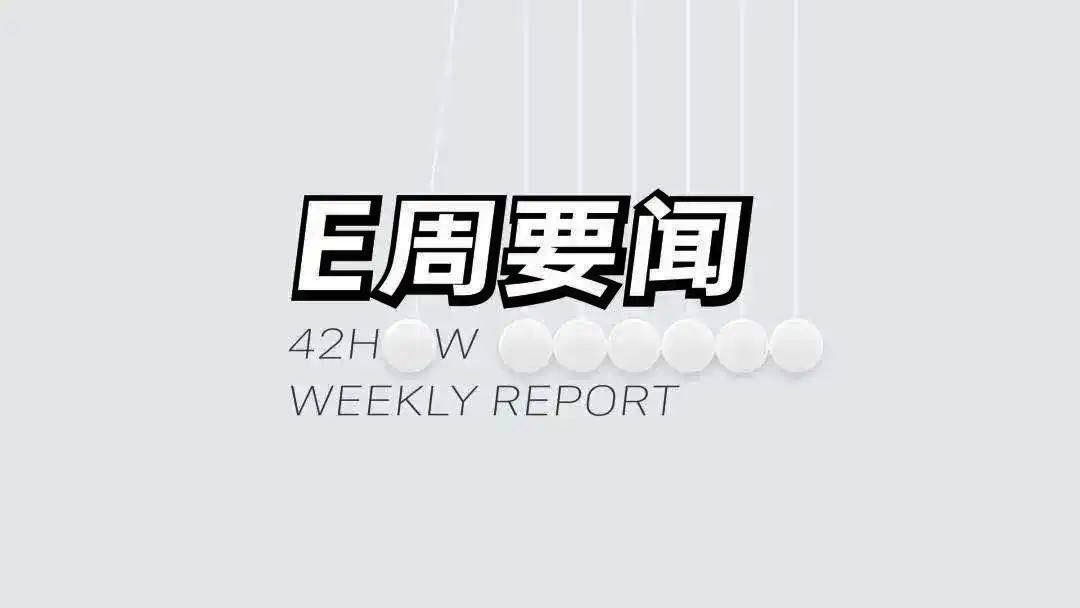Weekly Index
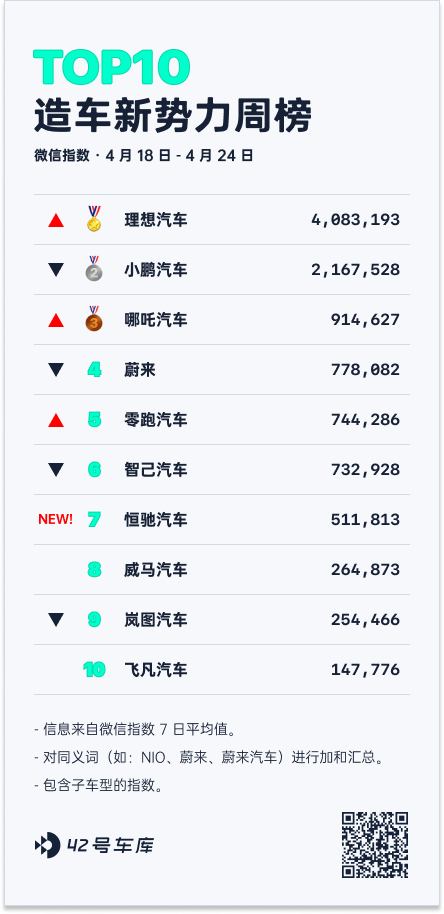
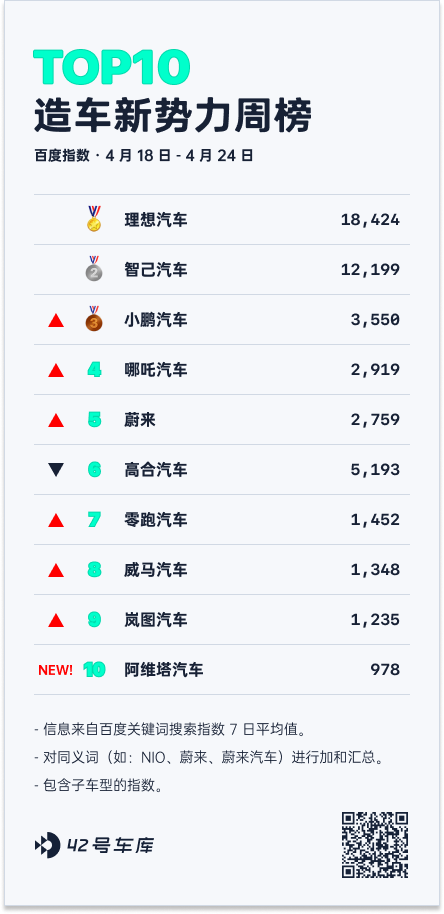
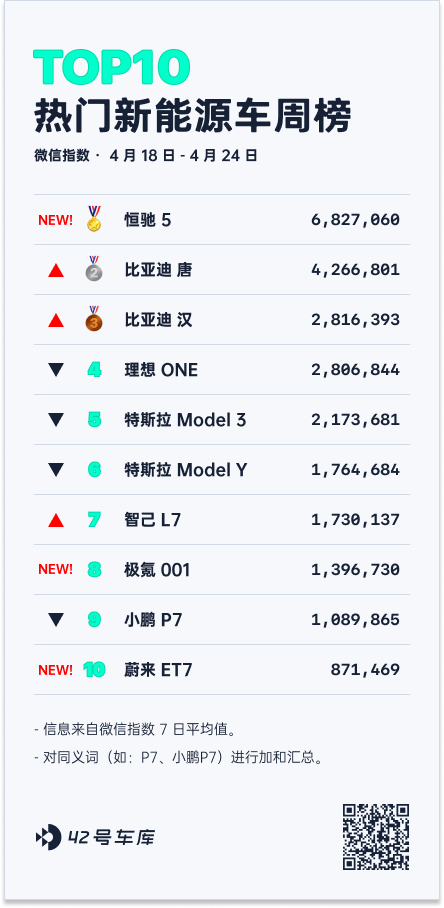
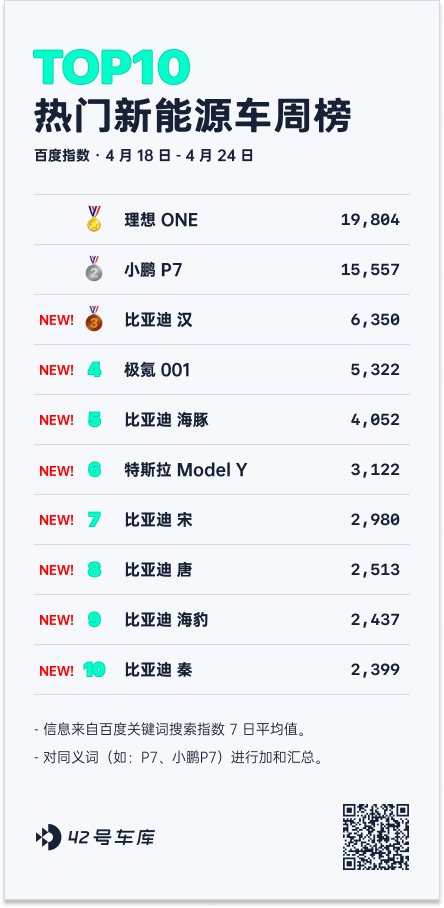
Weekly News
Tesla 2022Q1 Earnings Report: Total Revenue was $18.756 Billion, Year-On-Year Growth Slightly Slowed
Key data of Tesla’s Q1 earnings report for 2022 is as follows:
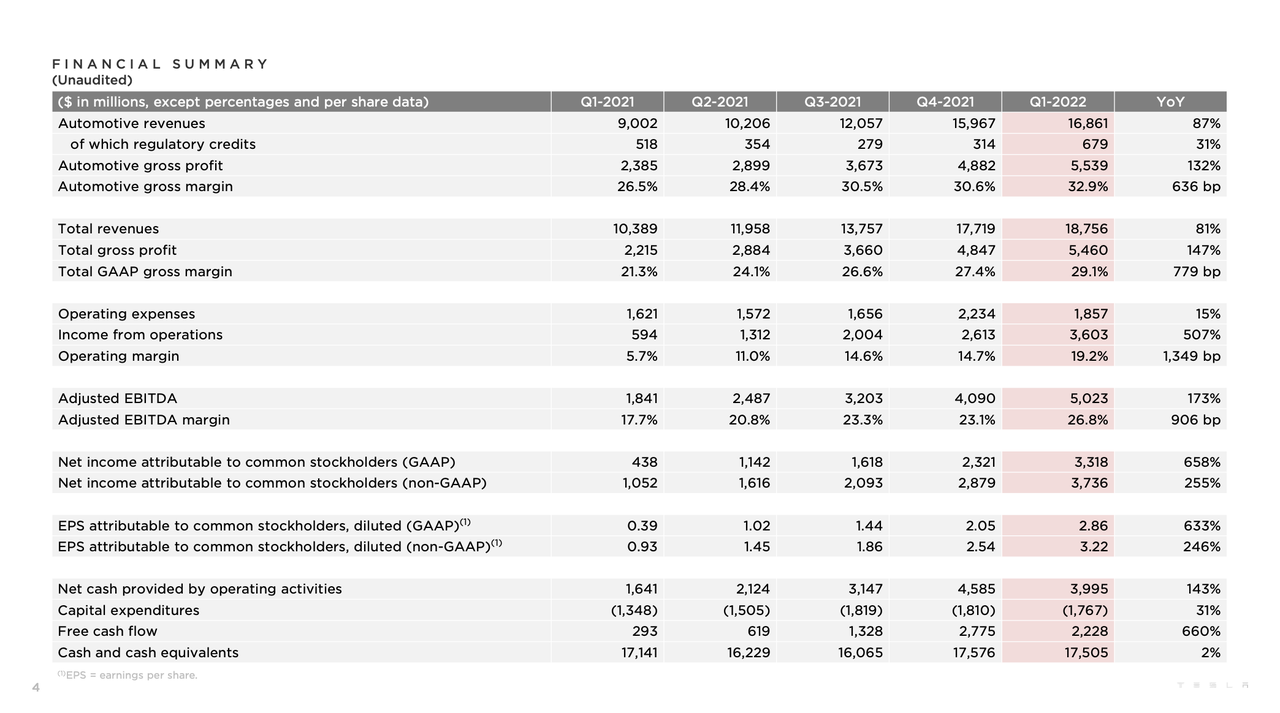
- Total revenue in Q1 2022 was $18.756 billion, an increase of 5.85% compared to the previous quarter and an 81% increase compared to the same period last year. Revenue from the automotive business was $16.861 billion (of which $679 million was from the sale of carbon emission credits), an increase of 5.6% compared to the previous quarter and an 87% increase year-on-year (carbon emission credit revenue increased by 31% year-on-year).- Automotive business gross profit was $5.539 billion, an increase of 13.5\% compared to the previous quarter and an increase of 132\% compared to the same period last year;
- Total gross profit was $5.460 billion, with an overall gross profit margin of 29.1\% and a gross profit margin per vehicle of 32.9\%;
- Cash and cash equivalents reached $17.505 billion;
- GAAP net profit was $3.32 billion;
- Operating cash flow minus capital expenditures (free cash flow) was $2.228 billion;
- GAAP revenue was $3.6 billion, with an operating profit margin of 19.2\%.
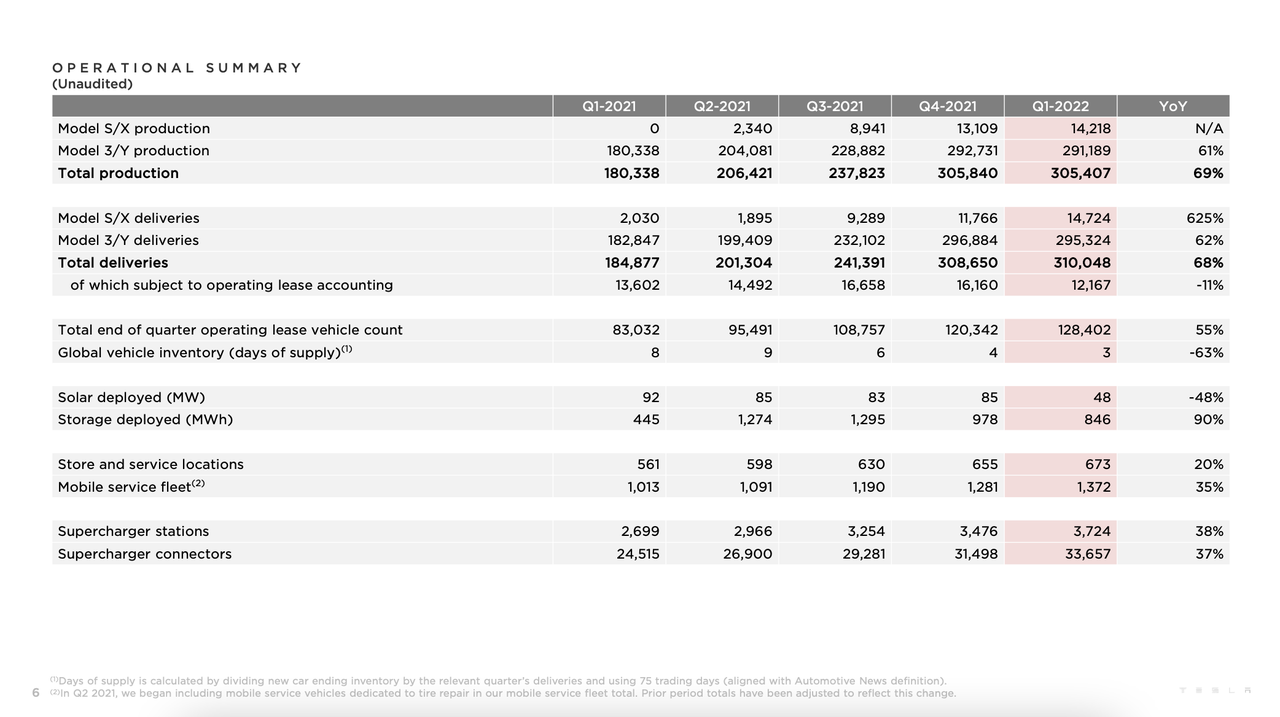
In terms of production and delivery, Tesla’s total production for 2022Q1 was 305,407 vehicles: Model S/X produced 14,218 vehicles, and Model 3/Y produced 291,189 vehicles, which is basically the same as in Q4. The total delivery volume for 2022Q1 was 310,048 vehicles: Model S/X delivered 14,724 vehicles, and Model 3/Y delivered 295,324 vehicles. The average global market inventory cycle is 3 days, which is 1 day shorter than the previous quarter and a 63\% reduction from the same period last year.
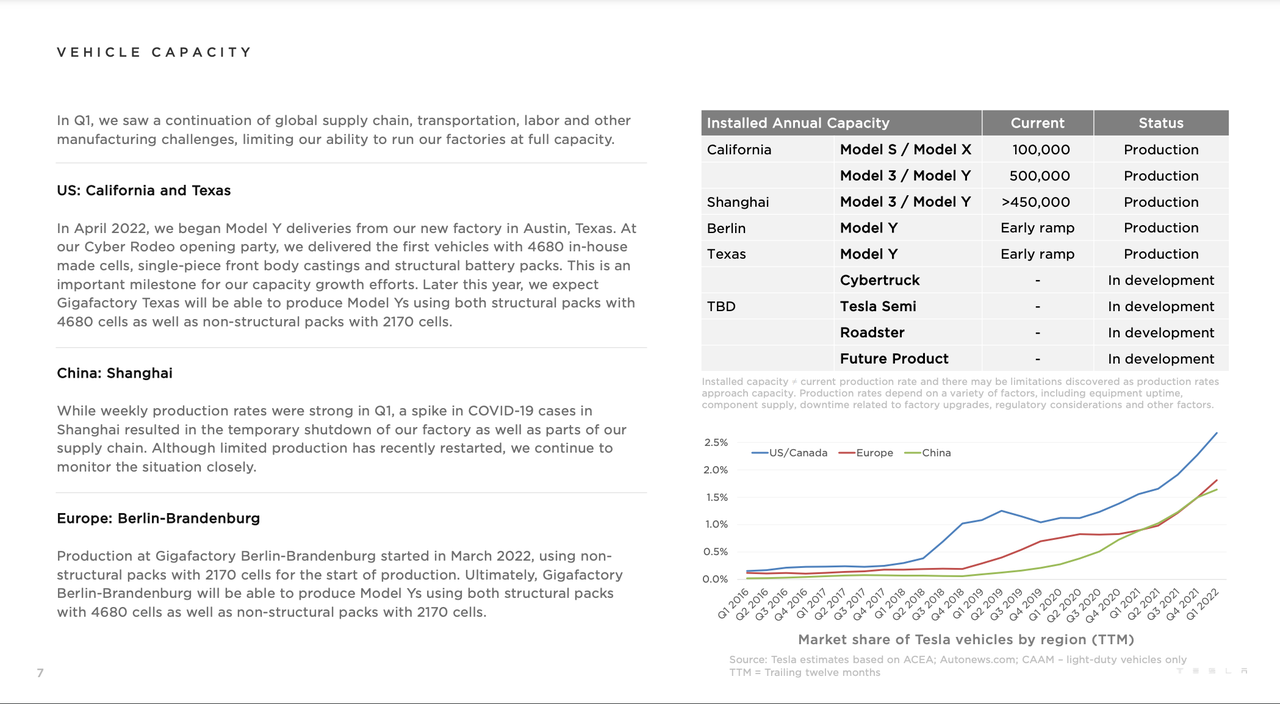
Regarding the factories, the Texas Gigafactory started production and delivery of the Model Y with the 4680 battery in April 2022. The Shanghai Gigafactory was temporarily shut down due to the pandemic, and suppliers were also affected, but it has gradually resumed production capacity. The Berlin Gigafactory began production in March.
Quick Comment:
Since Q3 2019, Tesla has been in a high-speed growth phase with gross profit breaking $1 billion each quarter. From 2020, the per-vehicle gross profit margin of Tesla has maintained a steady rate of over 20\% (except for 19.2\% in 2020Q4). Tesla still maintains an advantage in vehicle design concepts and cost scaling over other automakers.
The “SEXY” product lineup based on Model S, Model X, Model 3, and Model Y has achieved Tesla’s strong profitability in the vehicle hardware business and abundant cash flow. The launch of Cybertruck, Semi, and Optimus in the future gives people great expectations for the “Tesla universe”.Compared to the hardware profits of building cars, Tesla’s software service profitability road is “long and arduous”: although Tesla has explicitly stated that software services will be the focus of its business, the bottleneck in the progress of FSD Beta and the low FSD subscription rate in the Chinese market still pose significant challenges to Tesla’s vision.
NIO’s Battery Swap Brand EVOGO is Launched
On April 18, 2022, the first four battery swap stations of NIO’s battery swap brand EVOGO were put into operation in Xiamen, Fujian. It is expected to complete the construction and operation plan of 30 swap stations in Xiamen by the end of 2022, realizing the goal of “one swap station within a service radius of every 3 kilometers on Xiamen Island”.
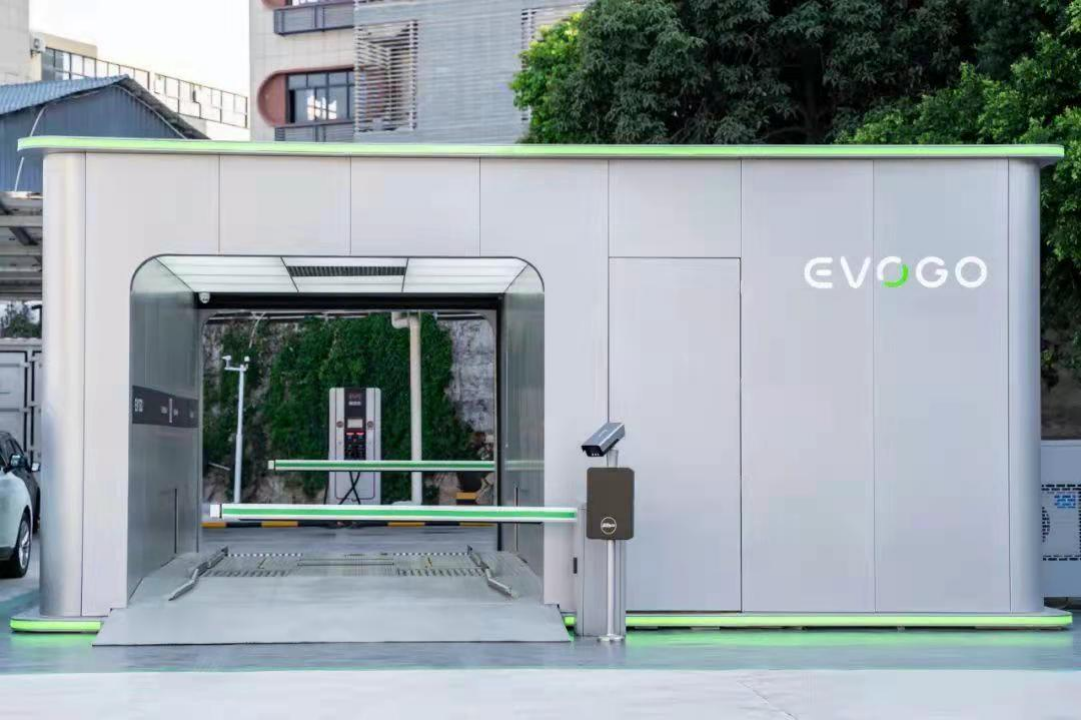
Along with the EVOGO battery swap station was the release of a battery module unit called “Chocolate Battery Swap Block”. The capacity of one chocolate battery swap block unit is 26.5 kWh, which supports CTP and wireless BMS technology, with a weight energy density of more than 160 Wh/kg and a volume energy density of more than 325 Wh/L. Contemporary Amperex Technology Co., Limited (CATL) claims that battery swap technology based on chocolate battery blocks “can adapt to models of pure electric platforms that have been listed globally by 80% and those that will be listed in the next three years”. The monthly rental for each chocolate battery swap block is at least RMB 399.
There are two main operation modes for NIO’s EVOGO battery swap station:
-
Cooperative operation of battery swap stations. Partners can choose to cooperate with Contemporary Amperex Technology in the field of battery swap through joint venture or franchise;
-
Vehicle purchase (not less than 100 vehicles). After the partners purchase the vehicles, Contemporary Amperex Technology will build battery swap stations and provide battery leasing services to the partners.
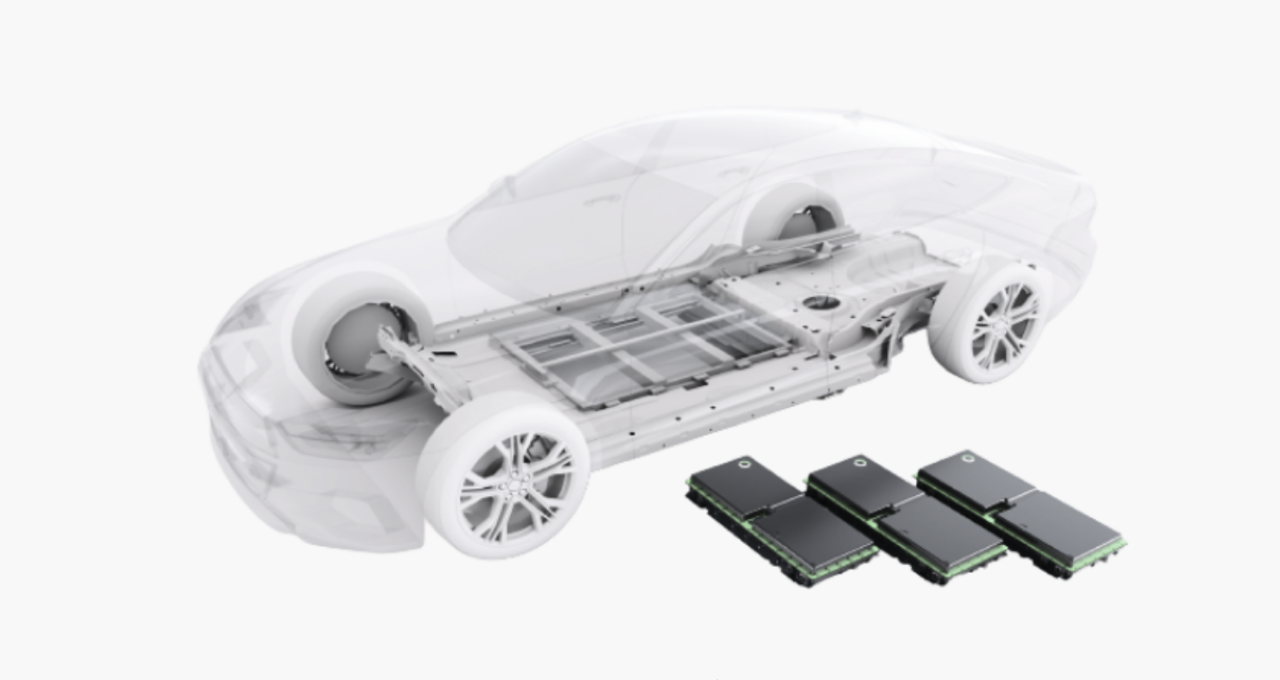
Final Comment:
Battery swapping solves the problem of slow power supplementation for electric vehicles–achieving power supplementation speeds that are close to or even surpass those of traditional fuel vehicles is the most important value of battery swapping. In addition, because vehicles that support battery swapping do not need to stick with a battery pack “from beginning to end,” it can improve the unfavorable situation where the residual value of pure electric vehicles is affected by battery degradation. By supporting battery swapping design, the specifications of power batteries can be adjusted according to demand during the vehicle’s lifespan. As batteries are quickly iterated and have capacity decay, which is a loss part, supporting battery swapping makes upgrading pure electric vehicles easy and efficient.One of the biggest problems facing the battery swap model is still too expensive. For pure electric vehicle design, the extra design to support battery swap would take up the chassis’s already limited space. Frequent disassembly and assembly would demand higher requirements for the mechanical reliability and vehicle operating costs. Meanwhile, battery swap operation requires the maintenance of a new and deteriorated battery pack fleet. And the convenience of a widespread station network implies a high operational maintenance cost.
As a supplier, CATL joined the battery swap business to turn the competition for battery swap resources among various brands into a public welfare of the industry, which is the greatest significance of the EVOGO brand. If CATL achieves the interchange of pure electric vehicle batteries from different manufacturers through EVOGO, it would have a very positive impact on the reduction of pure electric vehicle costs, and more varied and lower-priced models could appear on the market, promoting the development of the entire pure electric vehicle industry.
Zeekr 001 price increase scheme announced
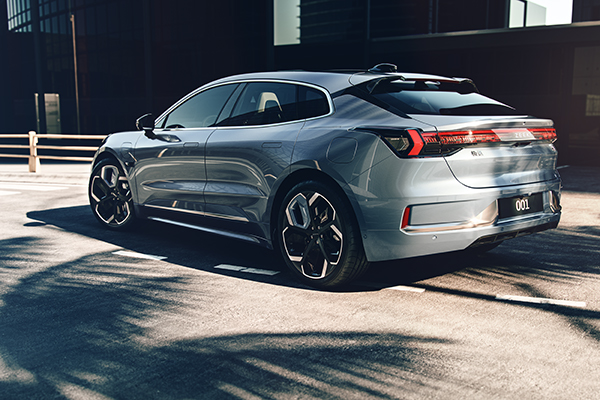
On April 22, Zeekr officially announced the price increase of the Zeekr 001 model, with the specific plan as follows:
-
The deposit inflation benefit of 5,000 yuan for the WE model was canceled and replaced with a comprehensive calculation of a 5,000 yuan price increase.
-
The YOU model price increased by 18,000 yuan, and the deposit inflation benefit of 5,000 yuan for 7,500 yuan was canceled, resulting in a comprehensive calculation of a 20,500 yuan price increase.
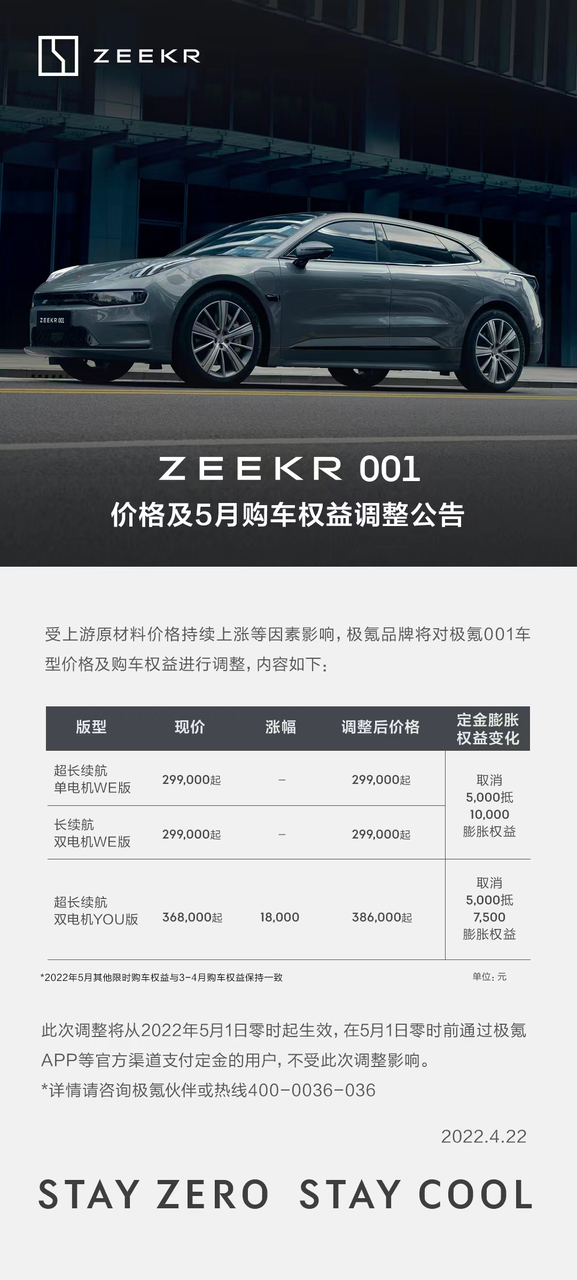
In addition, Zeekr announced that the price and benefits adjustment would officially take effect from zero on May 1, 2022. Users who paid the deposit through official channels such as the Zeekr App before zero on May 1 will not be affected by this price adjustment. In early April, Zeekr had announced that it would adjust the price of Zeekr 001 from May and reserved a one-month buffer period for the users.

Quick Comment:
Since the beginning of 2022, affected by factors such as a substantial rise in upstream raw material prices and tense global supply chains, the cost and supply chain pressure have caused many automakers to raise prices, and Zeekr is no exception. However, for the WE, the main delivery of long-endurance and single/dual motor, the primary price increase lies in “cancellation of the 5,000 yuan discount for the 10,000 yuan deposit”, and it can still enjoy national subsidies for new energy vehicles.The impact of power batteries and supply chains is expected to last for several months, and in the short term, it may be difficult to see a price drop in vehicle models due to cost reduction. Although subsidies for the purchase of new energy vehicle models will still exist in 2022, the improving product capabilities of pure electric vehicles allow models priced between 250,000-300,000 yuan to gradually become more competitive without relying on purchase subsidies. In other words, the increase in battery costs will hurt the most for pure electric vehicles priced around 150,000-200,000 yuan. If the cost of power battery packs remains high in the future, the room for maneuverability of models priced around 150,000-200,000 yuan will be limited in other aspects, which is not a good trend for the popularity of pure electric vehicles.
Changan Shenlan Launches Its First Model C385 and EPA 1 Launches its Platform
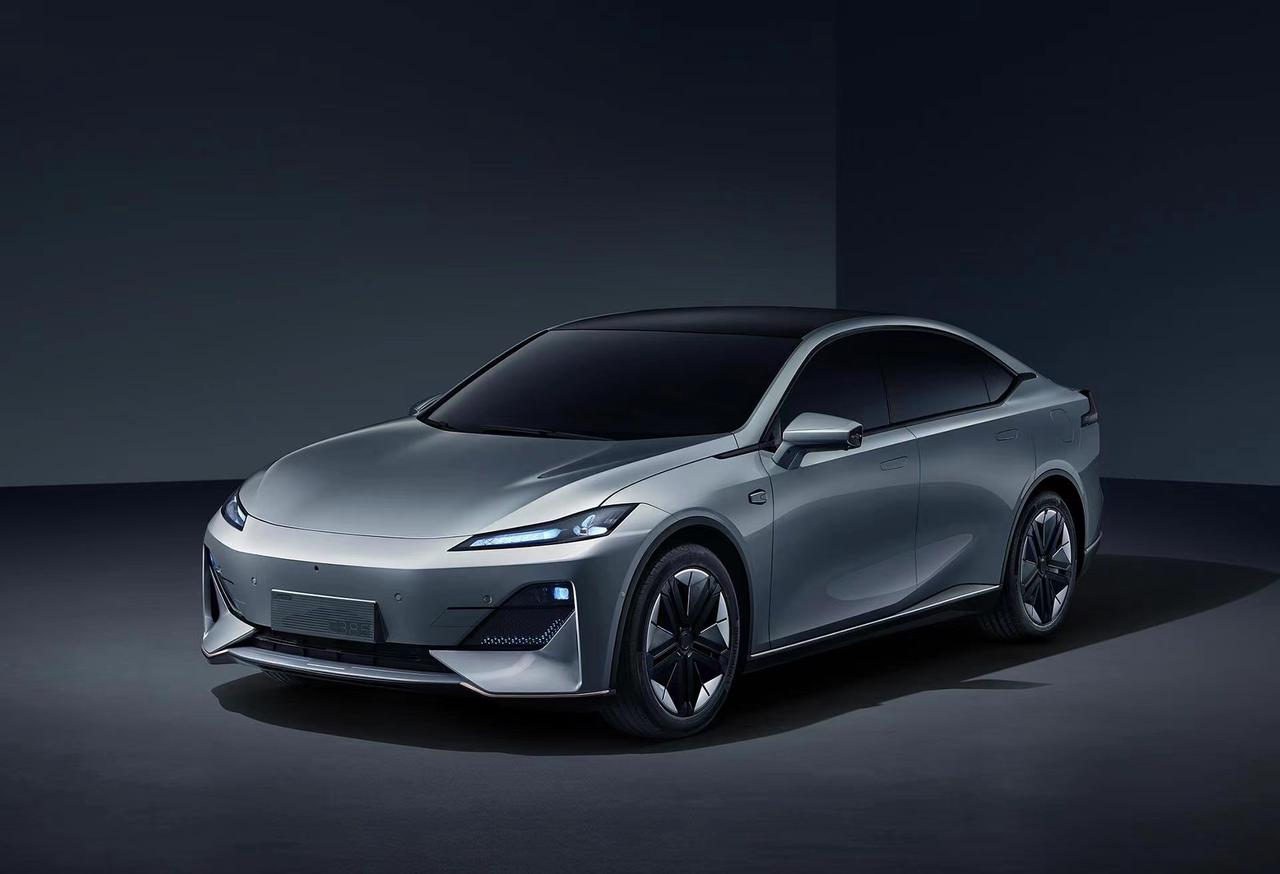
First, let’s take a look at the main parameters of the first model C385 on the EPA 1 platform:
-
Length, width and height: 4,820 x 1,890 x 1,480 mm, wheelbase 2,900 mm;
-
It adopts frameless doors and lift-back design and hidden door handles;
-
Rear-wheel drive single motor, maximum power 190 kW, 0-100 km/h acceleration in 5.9 seconds;
-
Official CLTC range exceeds 700 km, CLTC comprehensive power consumption is 12.3 kWh;
-
The interior features a 14.6-inch large screen, and the intelligent cockpit adopts the Qualcomm 8155 chip and peripheral multi-processor collaborative design.
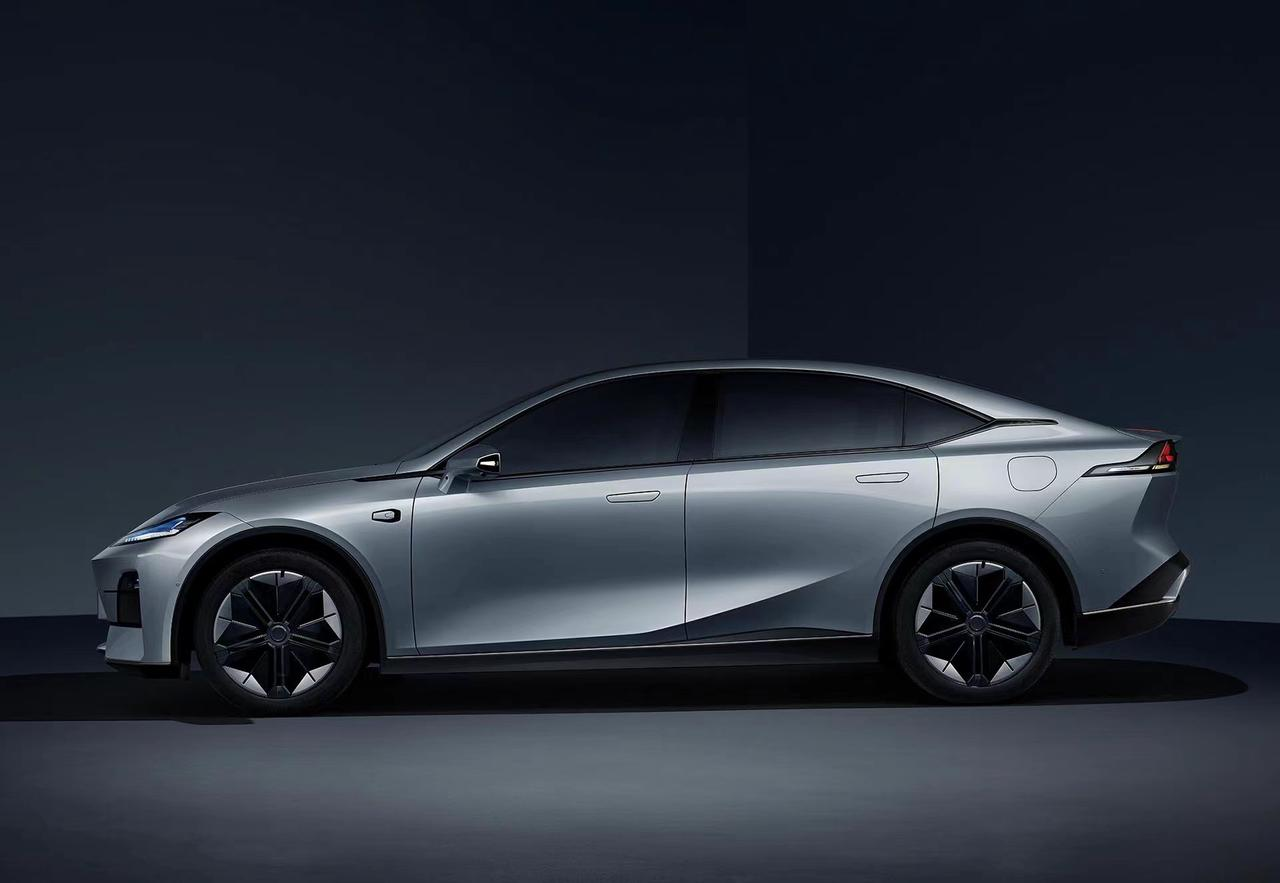
In addition to the pure electric configuration, C385 also has a range-extender and hydrogen fuel cell configuration: the range-extender model has a pure electric range of over 200 km, comprehensive range of more than 1,200 km, and fuel consumption of 4.5 L/100 km: The range-extender system under the EPA 1 platform can generate about 3.3 kWh of electricity with one liter of fuel consumed, and the power generation efficiency of the hydrogen fuel cell system can reach 20.5 kWh with one kilogram of hydrogen, and refueling takes only three minutes. The EPA 1 platform also adopts “pulse heating technology”, which can increase the battery temperature by 4 degrees Celsius per minute in an environment of minus 30 degrees Celsius, reducing the charging time in low-temperature conditions and enhancing the power output performance.
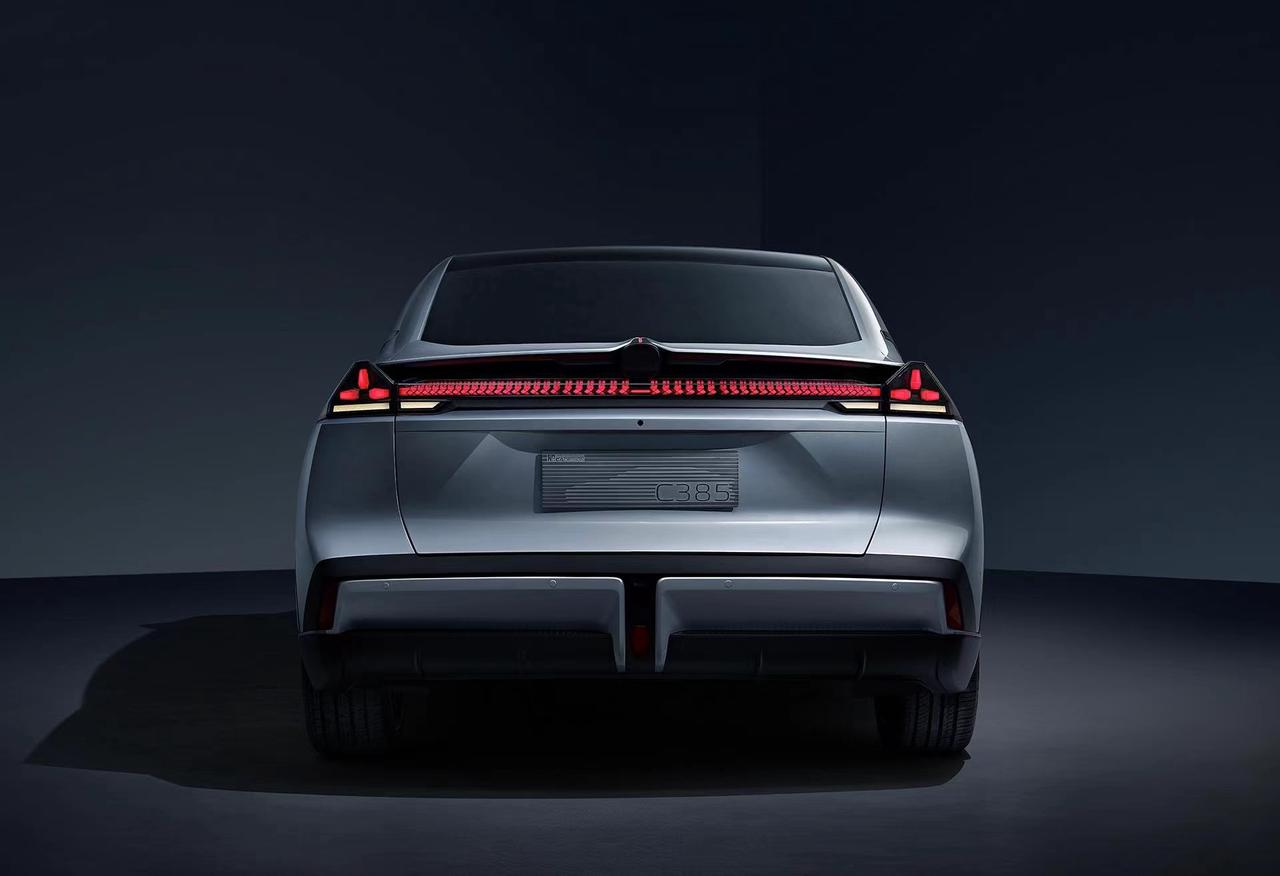 Regarding the advanced driver assistance features, the EPA 1 platform can achieve navigation-based driving assistance based on high-precision maps, covering scenarios such as automatic lane changing, ramp merging, and automatic following. In terms of automatic parking, within structured parking lots, the EPA 1 platform can achieve path memory parking, remote summoning, as well as automatic parking and remote summoning based on high-precision maps.
Regarding the advanced driver assistance features, the EPA 1 platform can achieve navigation-based driving assistance based on high-precision maps, covering scenarios such as automatic lane changing, ramp merging, and automatic following. In terms of automatic parking, within structured parking lots, the EPA 1 platform can achieve path memory parking, remote summoning, as well as automatic parking and remote summoning based on high-precision maps.

In terms of electrical and electronic architecture, the EPA 1 platform supports the SOA (Service-Oriented Architecture) technology, with OTA update speeds of the three major domain controllers, including the vehicle domain, cockpit domain, and intelligent driving domain, all within just 3 minutes. The EPA 1 cockpit domain has developed a dual partition upgrade technology that can prevent the vehicle from being put out of commission due to a failed system upgrade. This technology can complete software updates without affecting the normal use of the vehicle, as well as avoiding the risk of vehicle failure due to upgrade failures.
Quick review:
In 2017, Changan Automobile proposed the “Shangri-La” plan for investing 100 billion yuan in the new energy field. Five years later, the EPA 1 platform can be considered the first step towards Changan Automobile’s new energy plan. The EPA 1 platform provides broad possibilities for Changan Automobile’s new energy future: the C385 based on the EPA 1 platform has three configurations including pure electric, extended range, and hydrogen-electric configurations.
The EPA 1 platform also provides a solid foundation for the C385, with a front and rear axle weight distribution of 50:50, rear motor with a maximum power of 190 kW, and a 0-100 km/h acceleration of 5.9 seconds. With the addition of the SOA technology, the C385 has three major domain controllers, including the vehicle domain, cockpit domain, and intelligent driving domain, supporting the expansion of SOA services and a 3-minute OTA update across the entire vehicle.
Changan Deep Blue C385, BYD Hippo, and other models are ready to go, and the future pure electric car market may usher in a “vibrant and diverse” situation.
Momenta AI Day: NOH City Release, MANA Data Intelligence Latest Developments
On April 19, 2022, Momenta AiDrive held its first AI Day event of the year. Let’s take a look back and forward:
-
Since May 2021, after the launch of WeiPai Mocha as the first model equipped with Momenta’s HWA high-speed intelligent driving system, Momenta’s intelligent driving products have successively been installed on the Tank 300 City Edition, Haval God of War, and other 5 car models.
-
In November last year, Momenta AiDrive officially launched the high-speed NOH. The WeiPai Mocha equipped with the Momenta NOH system became the world’s first fuel vehicle with intelligent driving functions.- As of April this year, the total driving mileage of users equipped with Momenta’s high-speed intelligent driving system has exceeded 7 million kilometers. Momenta’s long-term goal is to pre-install 1 million vehicles within the next three years.
Momenta’s 2022 “Three Major Campaigns” focus on three aspects of data intelligence technology, intelligent driving scenarios, and end-to-end logistics and automatic delivery vehicles.
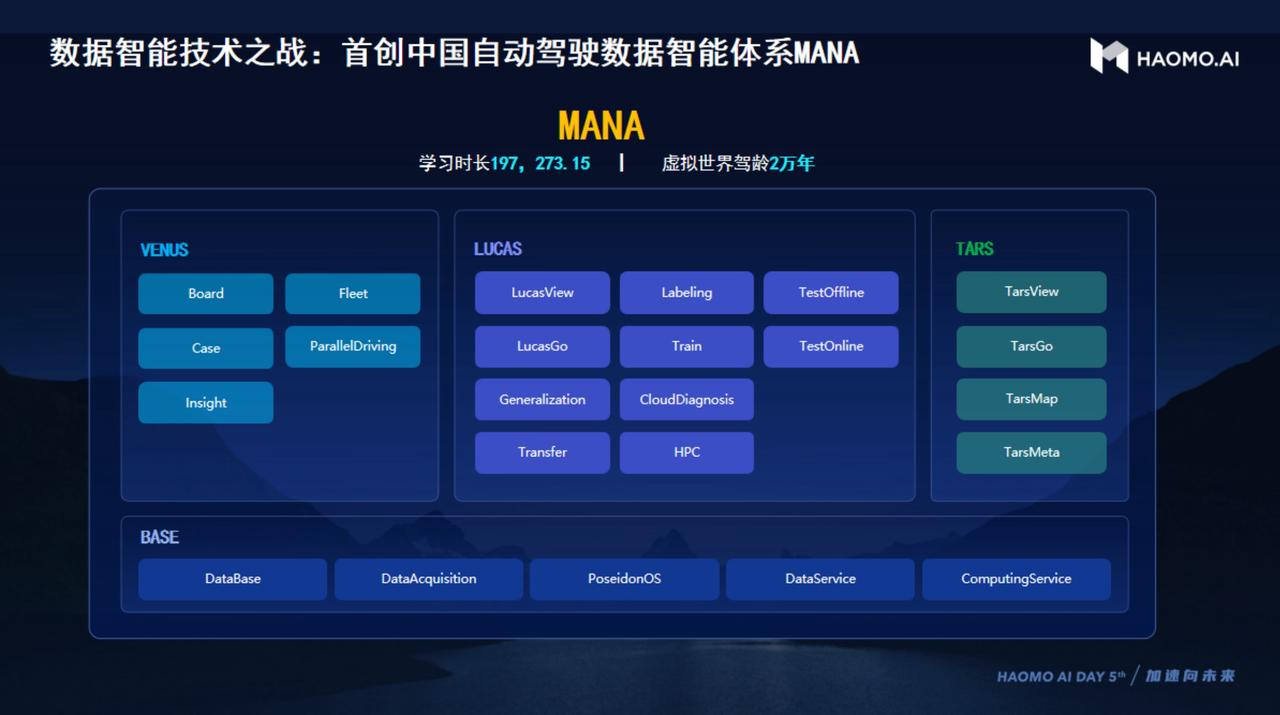
In terms of data intelligence technology, Momenta released the MANA data intelligence system at the end of 2021, which can transform data into knowledge, iterate products at a lower cost and faster speed, and provide users with safe and easy-to-use products. Three months later, MANA’s perception capability was greatly improved, driven by the strengthening of chip computing power and camera quality, among other factors. In 2022, MANA will improve the performance of traffic light recognition and Transformer lane recognition, and address consistency and interpretability issues in driving strategies by choosing to collaborate with Alibaba and bringing the Alibaba M6 large model, which was originally applied to natural language processing, text generation and classification, and image classification, to the field of autonomous driving ahead of others.
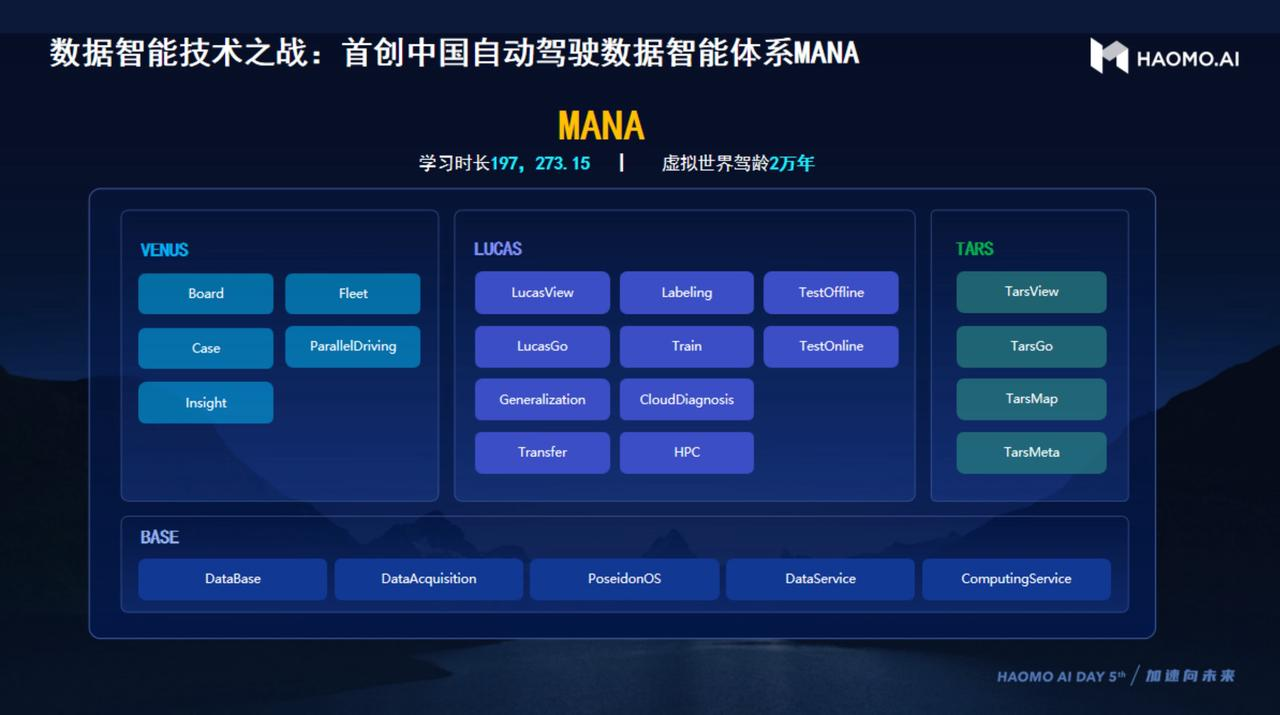
In terms of intelligent driving scenarios, Momenta has completed all of the features in the city NOH. It can achieve automatic lane changing and overtaking, traffic light recognition and control, complex intersection passage, and unprotected left and right turns in the urban environment. Currently, city NOH has been deeply polished in cities such as Beijing and Baoding, and vehicles equipped with the city NOH system will be officially put into mass production in the near future. Momenta also announced the “6P Open Collaboration Model”: as a supplier, Momenta can provide solutions to other companies without self-developed capabilities, and can also develop together with other companies. Cooperation can choose to adopt Momenta’s full-stack technology solution, cooperate with Momenta at the data intelligence cloud service level, or cooperate with Momenta at the software and hardware levels.
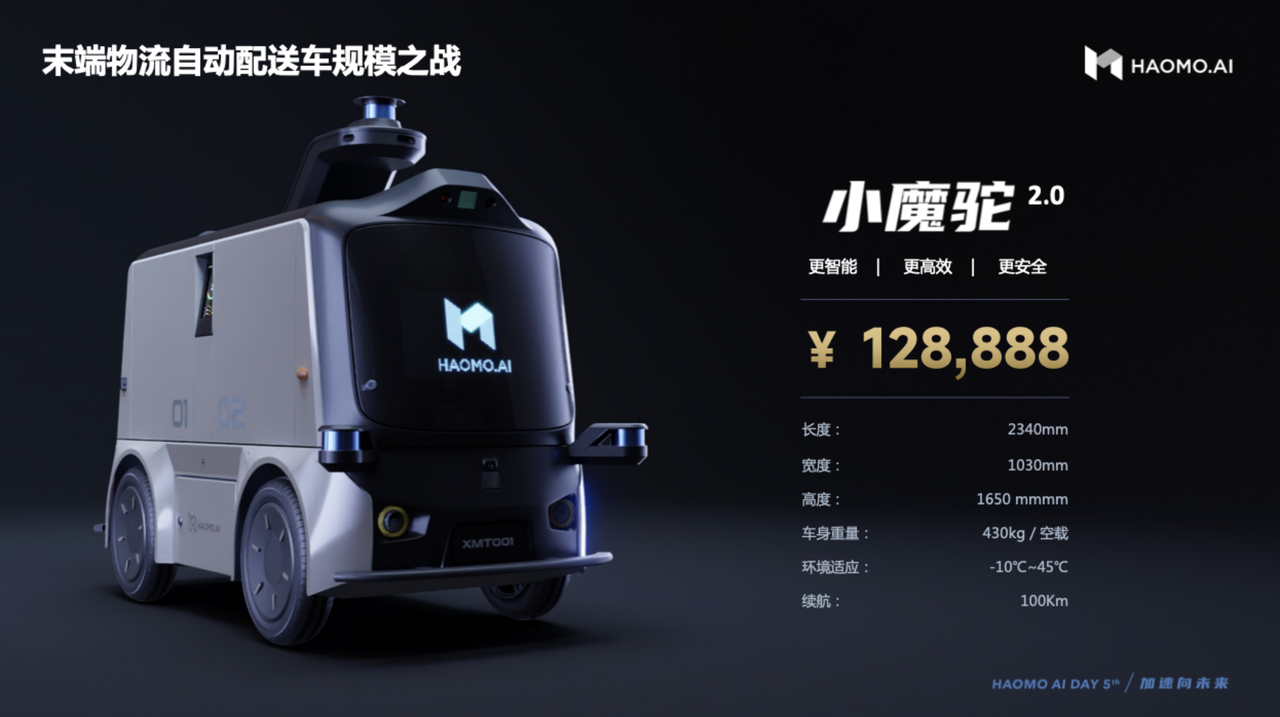 In terms of terminal logistics distribution, Hao Ma Zhi Xing has fully upgraded the production base of terminal logistics automatic delivery vehicles this year. The upgraded production workshop covers an area of 10,000 square meters and can achieve an annual production capacity of 10,000 unmanned delivery vehicles. At this AI DAY, Hao Ma Zhi Xing officially released the second generation of terminal logistics automatic delivery vehicle – Xiao Mo Tuo 2.0, with a final price of RMB 128,800. Xiao Mo Tuo 2.0 is equipped with the ICU 3.0 high computing power calculation platform and can customize a 600-liter cargo space box. In addition, it also supports intelligent voice, touch and other interactive methods.
In terms of terminal logistics distribution, Hao Ma Zhi Xing has fully upgraded the production base of terminal logistics automatic delivery vehicles this year. The upgraded production workshop covers an area of 10,000 square meters and can achieve an annual production capacity of 10,000 unmanned delivery vehicles. At this AI DAY, Hao Ma Zhi Xing officially released the second generation of terminal logistics automatic delivery vehicle – Xiao Mo Tuo 2.0, with a final price of RMB 128,800. Xiao Mo Tuo 2.0 is equipped with the ICU 3.0 high computing power calculation platform and can customize a 600-liter cargo space box. In addition, it also supports intelligent voice, touch and other interactive methods.
Finally, let’s take a look at Hao Ma Zhi Xing’s city NOH system: In terms of hardware, the HPilot 3.0 system is equipped with the Qualcomm 8540 + 9000 chip, with a computing power of 360 TOPS. It is also equipped with two laser radars, 12 cameras, and 5 millimeter wave radars. According to Hao Ma’s plan, the city NOH system will be officially put into production in June 2022, and the NOH system will be implemented in more than 100 cities in the next three years, covering domestic first-tier and second-tier cities.
Quick Comment:
Hao Ma’s 2022 targets are very clear, but also full of challenges:
Hao Ma plans to deliver 34 models and 78 projects in 2022. This not only tests Hao Ma’s R&D capabilities, but also the mobilization of organizational structure and the recruitment of talents.
In addition, Hao Ma will also open cooperation and become a “qualified” Tier-1 supplier. From the current cooperation with Great Wall, it is definitely a mutually beneficial thing for both parties. Hao Ma can provide Great Wall with the most competitive auxiliary driving capability, while a large number of front-loading cars can promote the development of MANA.
For Hao Ma, being the first to mass produce the city NOH seems to be only from 0 to 1. After that, making more friends, expanding the circle of friends, continuing to deepen R&D, and building a talent system… Hao Ma, which has made a good start in 2022, still has a lot of battles to fight.
BBA collectively launches new products: Mercedes-Benz EQS SUV, BMW New 7 Series, Audi Urbansphere Concept
Mercedes-Benz, BMW, and Audi, this group of happy enemies from Germany, simultaneously released new cars this week, all focusing on the three most common types of luxury vehicles in the market: Mercedes-Benz EQS SUV with SUV design, BMW New 7 Series and pure electric i7 with luxury sedan configuration, and the Audi Urbansphere Concept concept car, which reinterprets the MPV. Let’s take a look at their basic parameter comparison, and for reference, we also include the Tesla Model S (2021):

Mercedes-Benz EQS SUV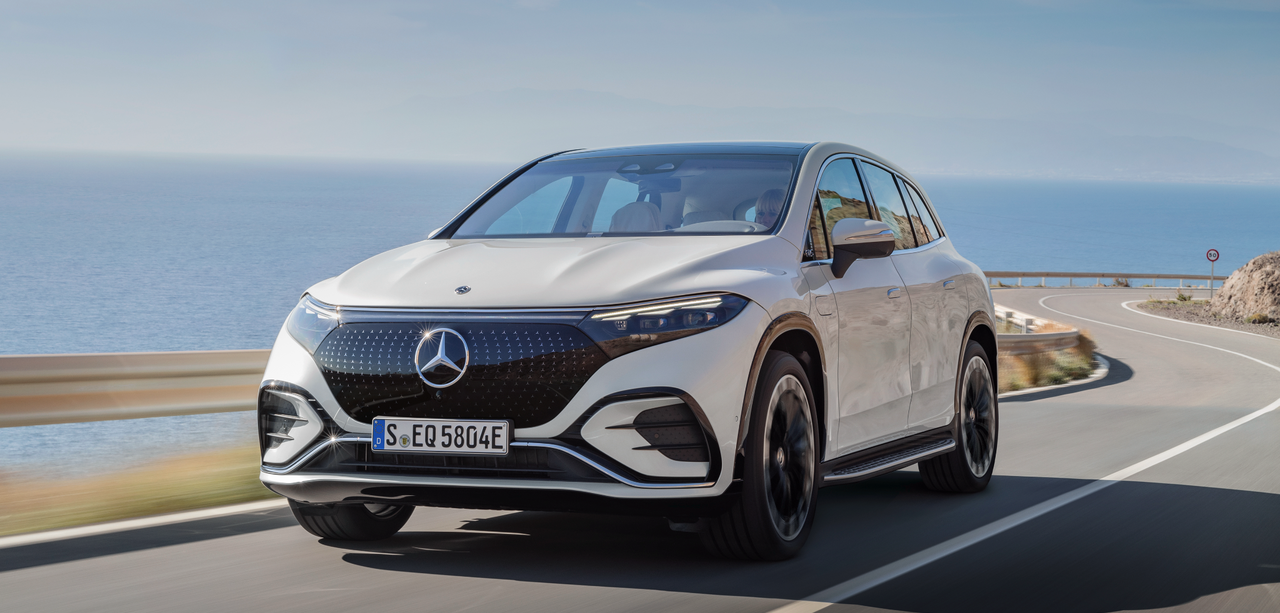
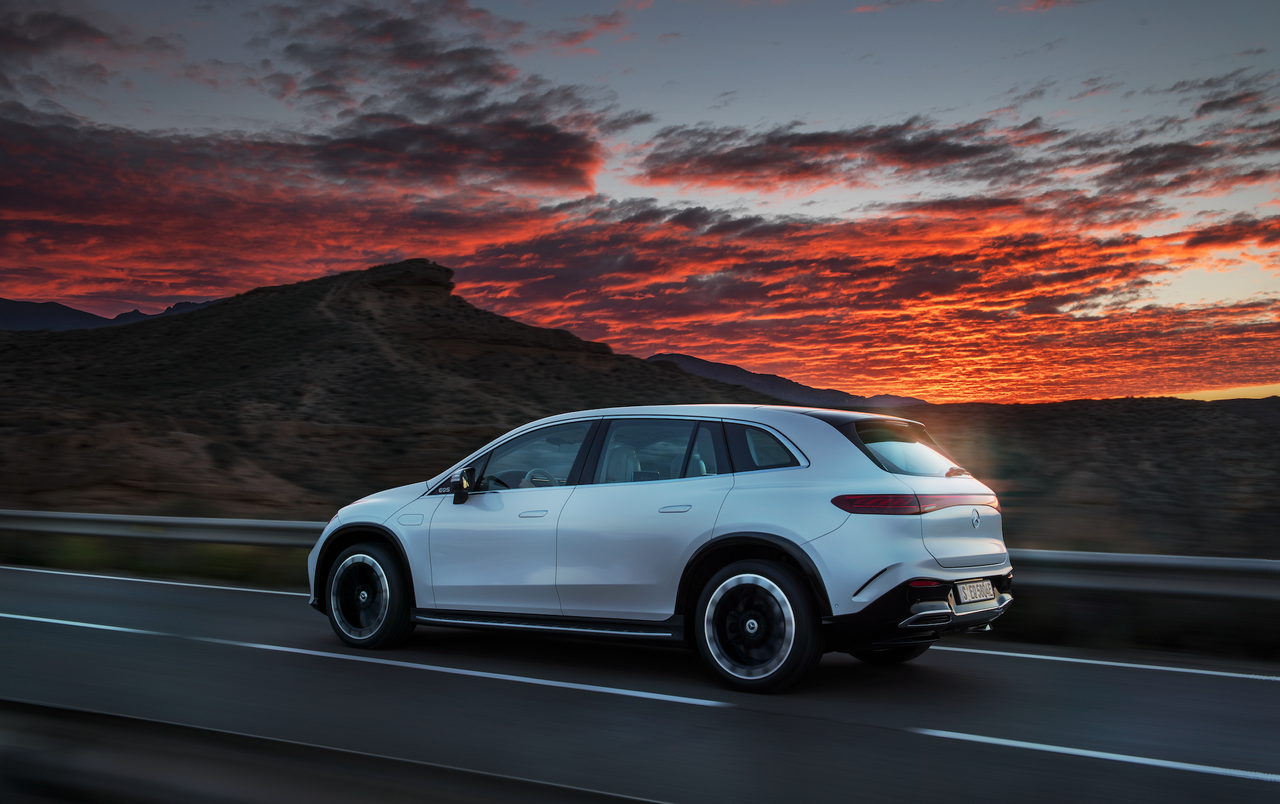
As for interior design, the EQS SUV is equipped with Dolby panoramic sound effects and a MBUX Hyperscreen that measures up to 141 cm, with an 8-core CPU and 24GB of memory (specific chip models not mentioned). The seven-seat layout is arranged in a “2 + 3 + 2” configuration.
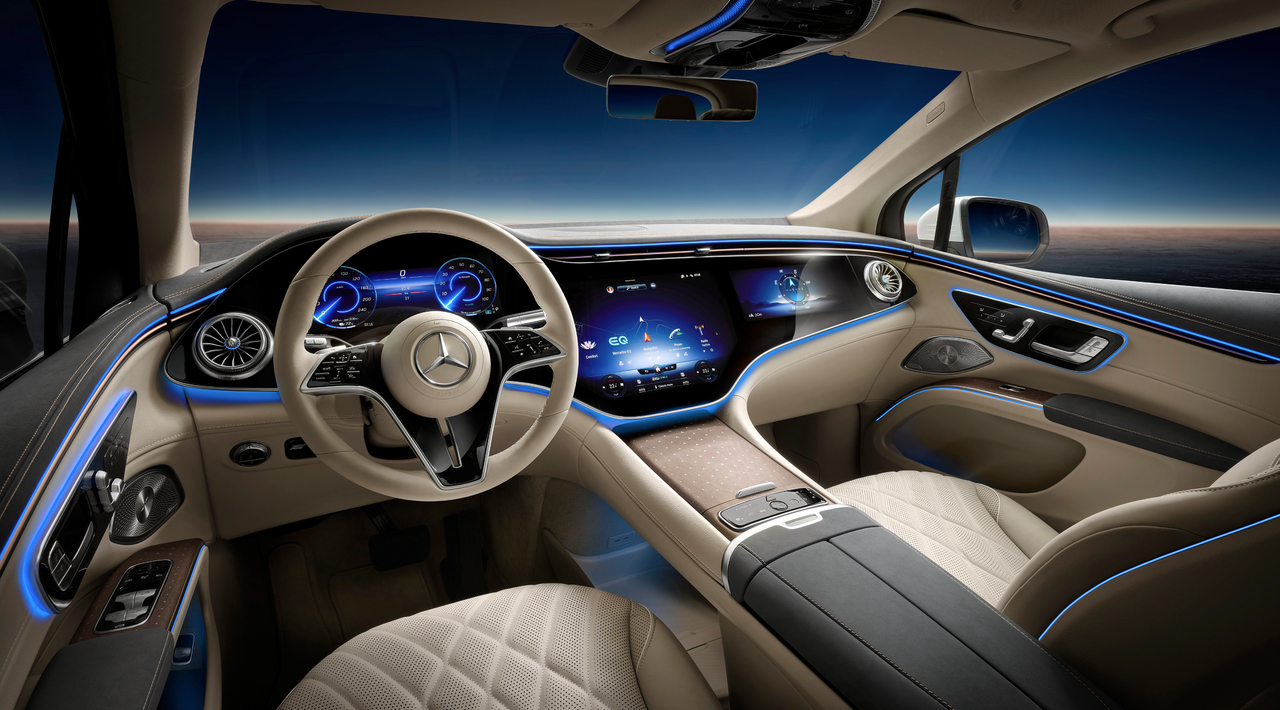
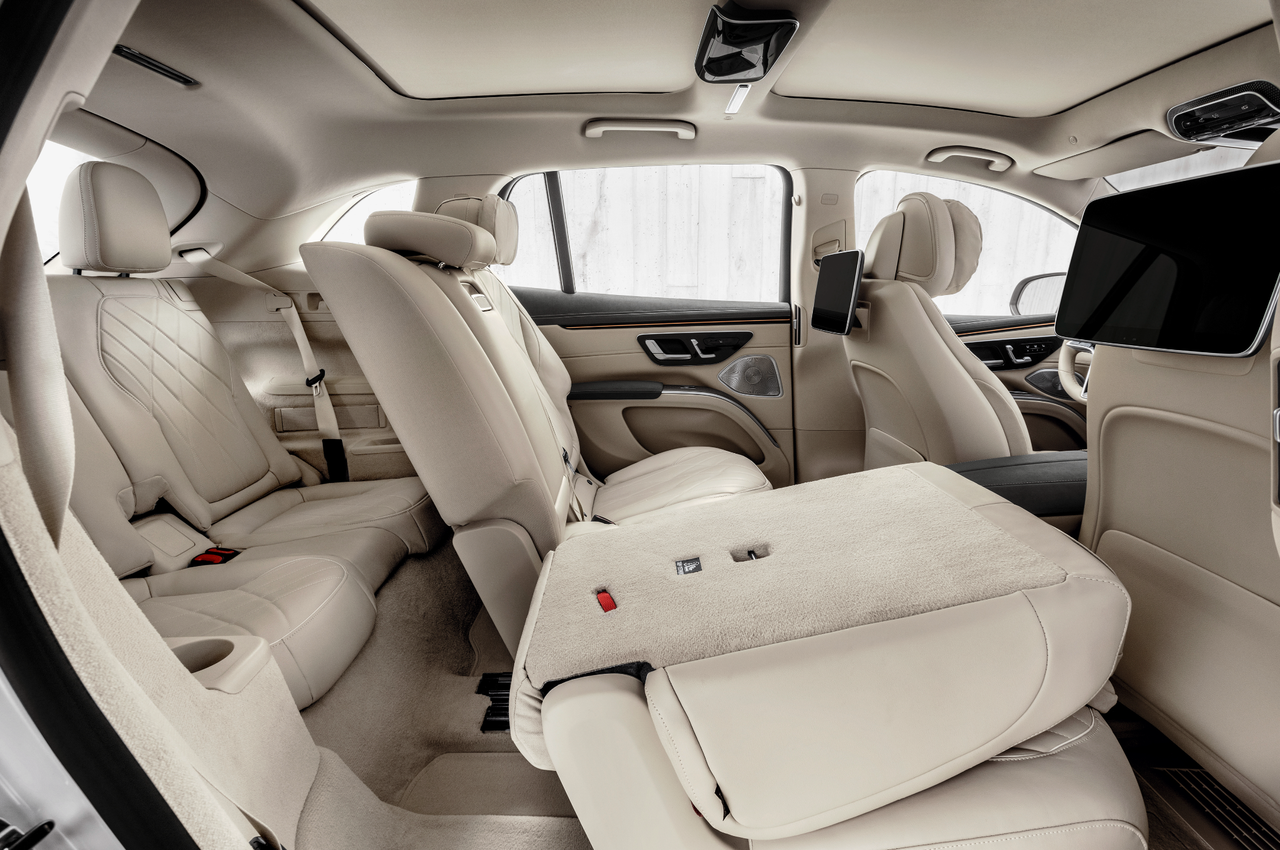
In addition to the basic HUD (heads-up display), Mercedes-Benz also offers an optional AR-HUD on the EQS SUV. The AR-HUD has an opening angle of 10 degrees horizontally and 5 degrees vertically, with a focal length of 10 meters. The image is equivalent to a 77-inch display, providing clear content for driving assistance and navigation information, allowing the driver to further immerse themselves in the environment in front of the car and reduce the chance of driver distraction.
Moreover, the EQS SUV will be equipped with Dolby panoramic sound (Dolby Atmos) audio system and an air filtration system with HEPA-level filters.
BMW’s New 7 Series
This “I want everything from fuel to electric” 7 Series includes three models: the all-electric i7 xDrive 60, the gasoline-powered 760i xDrive, and the plug-in hybrid M760e xDrive. The basic specs for the all-electric i7 have been listed, and here are the powertrain parameters for the gasoline-powered and plug-in hybrid 7 Series:
-The 760i comes with a 4.4 T V8 engine, while the M760e plug-in hybrid uses a dual-turbo 3.0 T S58 engine combined with an electric motor, with power outputs of 536 and 571 horsepower for the two respective models.
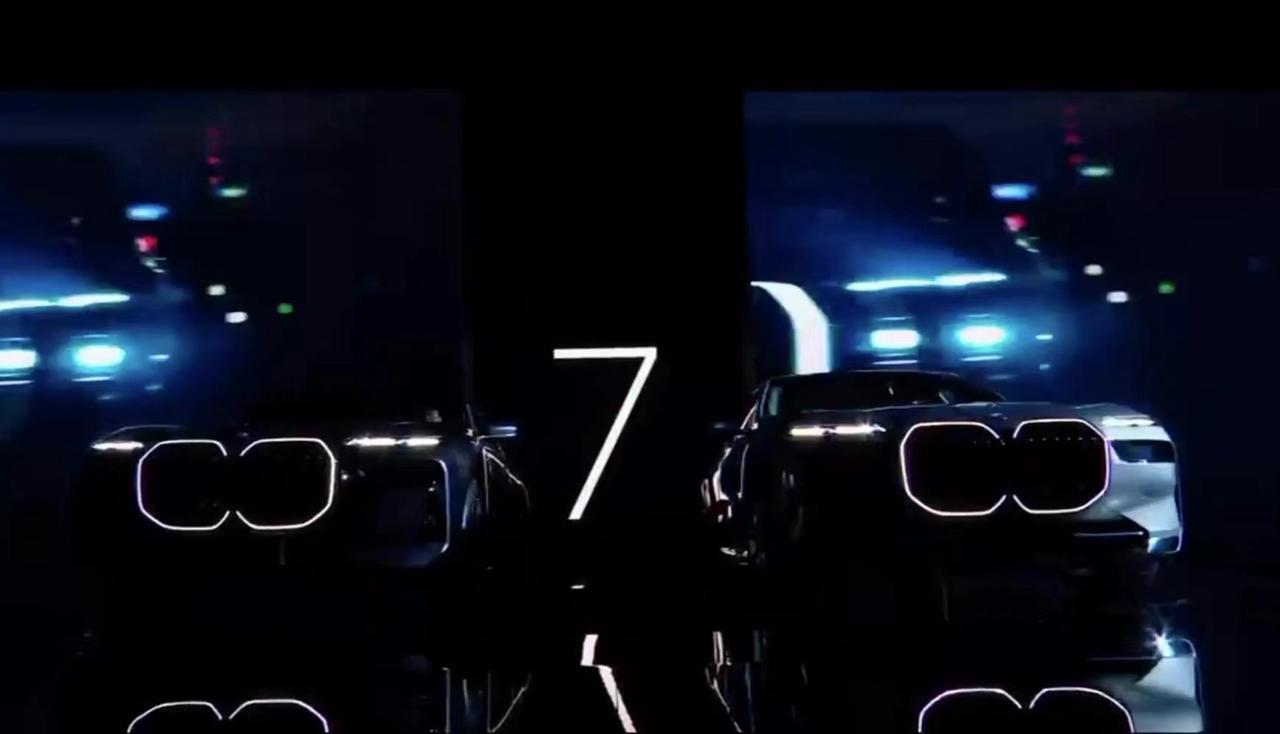
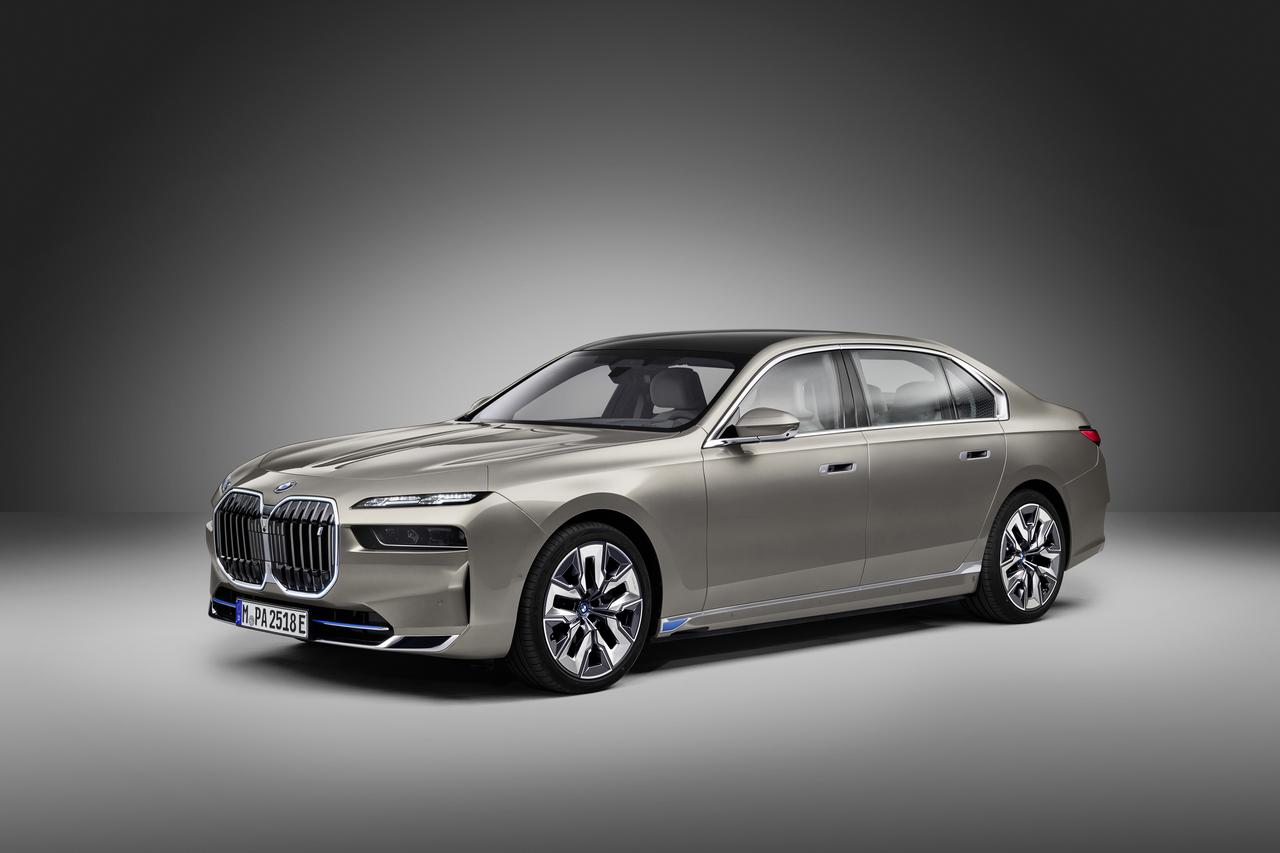 Please note that Markdown does not support image upload, the following English text only shows the image URLs.
Please note that Markdown does not support image upload, the following English text only shows the image URLs.

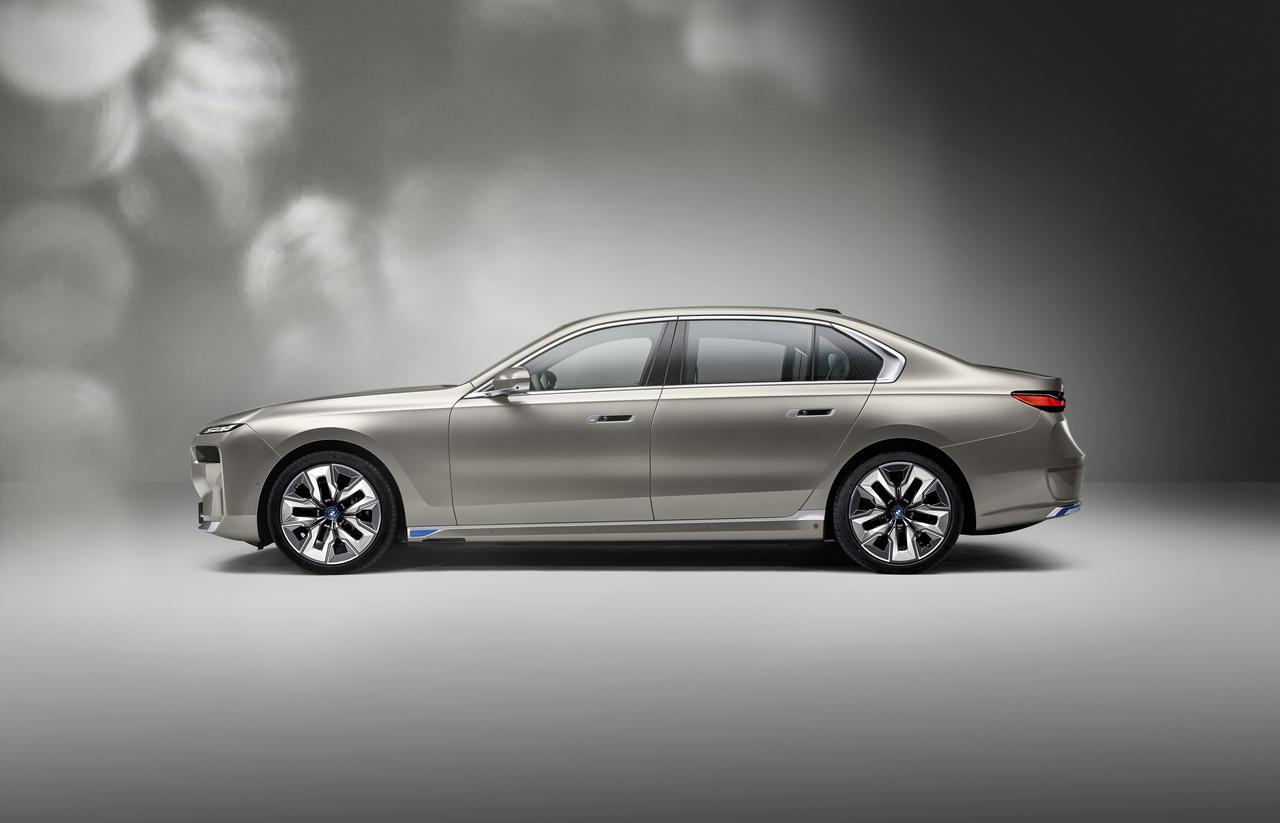
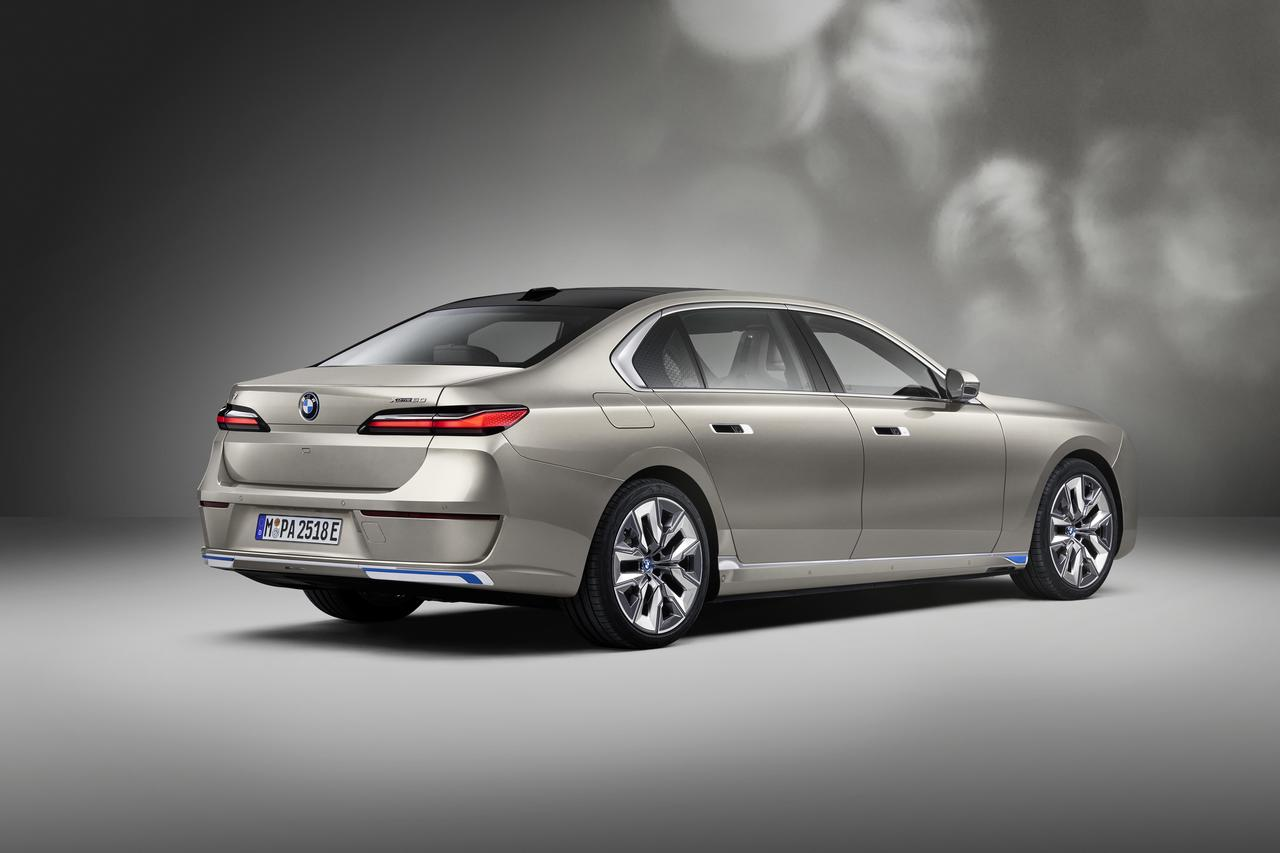
Regarding the interior design, the i7 adopts a new generation of 14.9-inch touch screen and 12.3-inch digital instrument cluster integrated suspended curved screen design, equipped with the latest BMW iDrive 8.0 system. The front row’s ambient lamp integrates touch control for air conditioning, multimedia, and other functions.
The rear seats are equipped with a 31-inch 8K (7,680 × 2,160) resolution 32:9 OLED screen. The PAD to operate this screen is located on the armrest on the left and right sides of the rear seats. There are also buttons around the PAD to control the door lock, door switch, privacy sunshade, and other functions. The sound system is a 36-speaker Bower & Wilkins 4D sound (total power 1,965 W, with vibrators for all four seats).
The onboard entertainment system supports 5G connectivity and can play internet streaming media content. BMW has cooperated with local video copyright holders and will support third-party video websites such as iQiyi in the future.
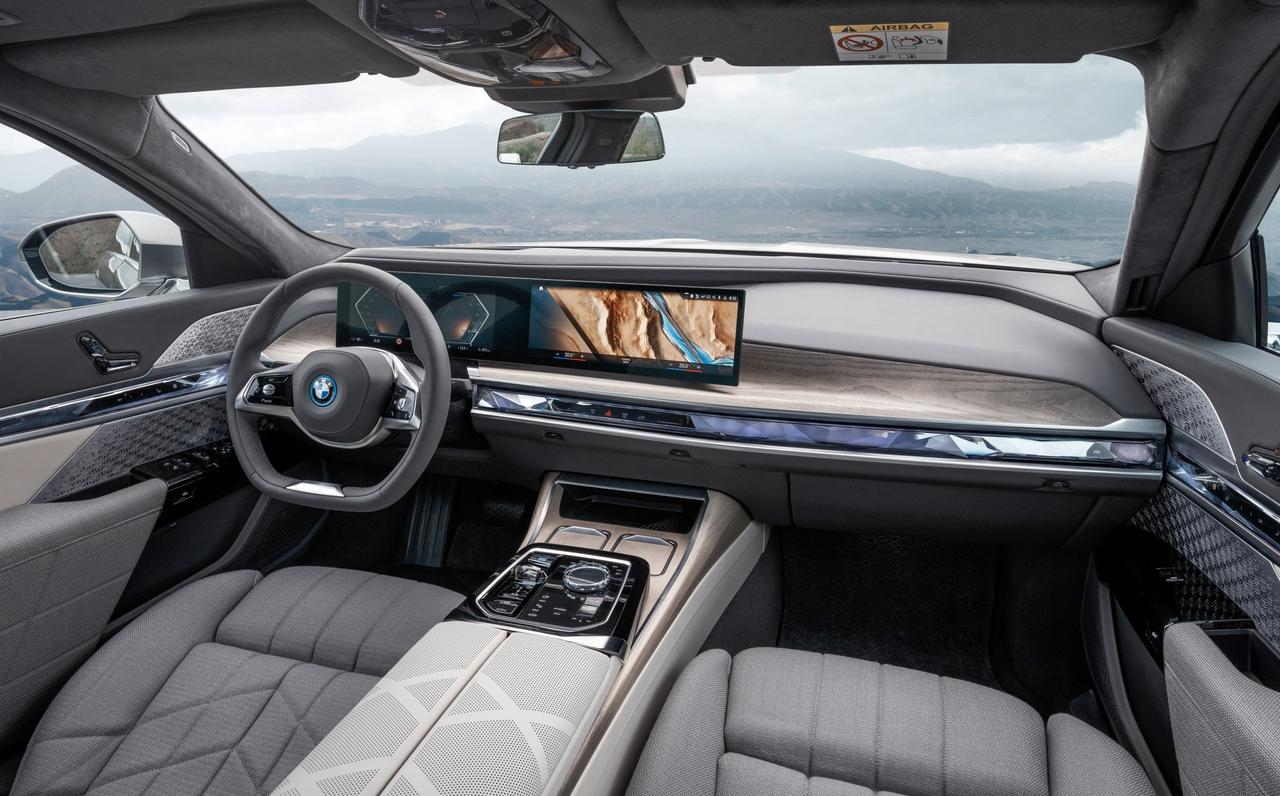
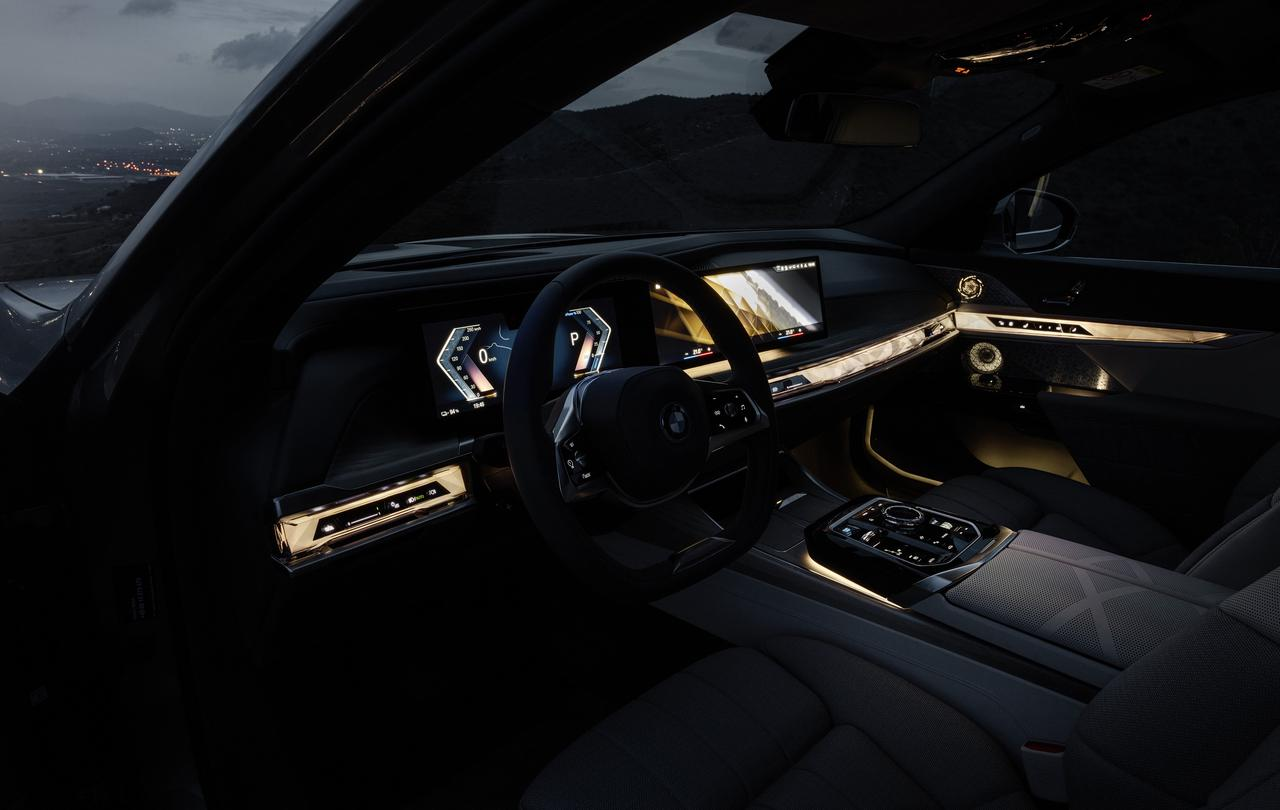

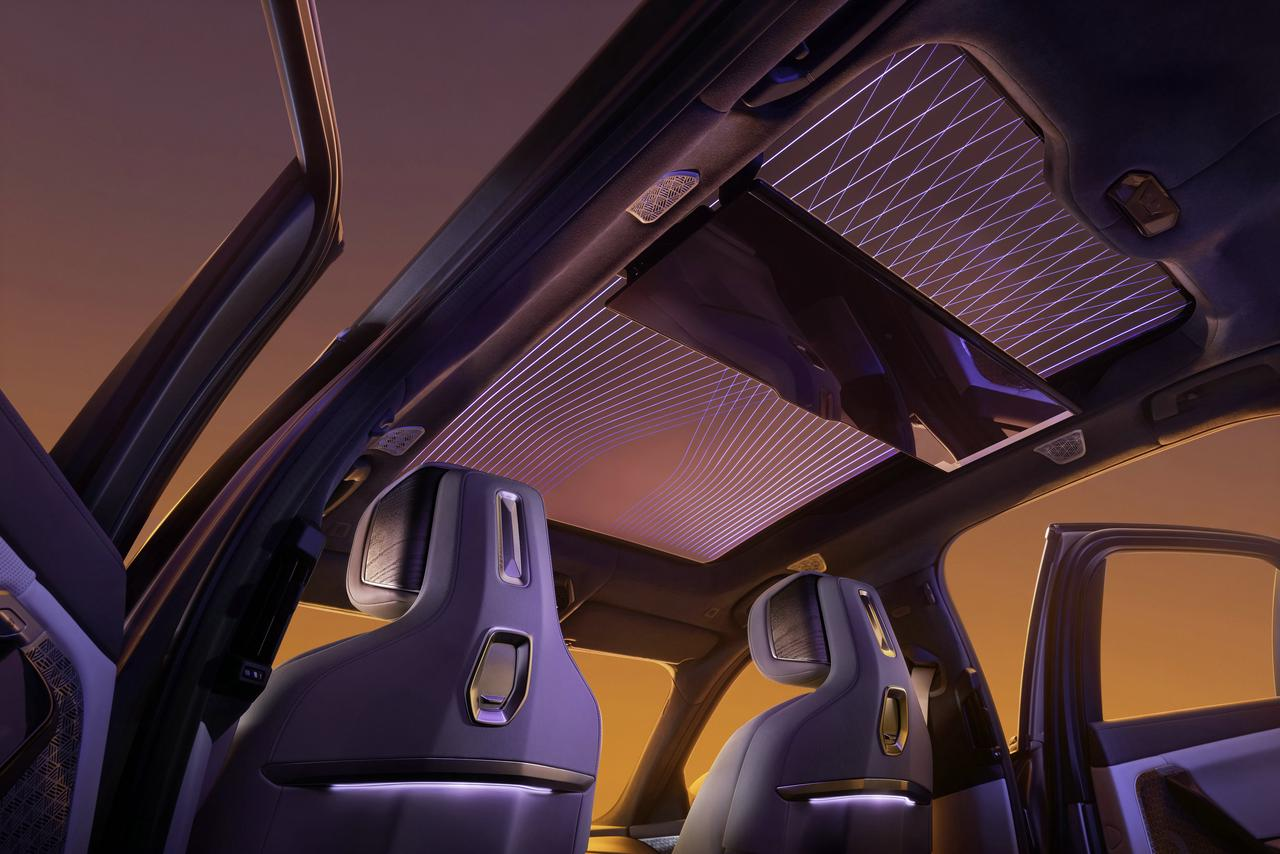
Regarding driver assistance, the i7 is equipped with more than 30 driver assistance sensors throughout the vehicle. In terms of sensor hardware, the “ingredient mixing” is reflected in the results. In some regions, the i7 can support up to L3 level of autonomous driving, which can recognize traffic signals and park by itself. After the advanced driver assistance package is installed, the allowed speed for adaptive cruise control can reach 210 km/h.
Audi urbansphere concept car# Urbansphere Concept: Audi’s Vision for the Third Living Space
Urbansphere Concept is a pure electric MPV concept car designed by Audi based on the PPE platform. With the help of autonomous driving technology, passengers can interact with the vehicle through voice, gestures, touch, and holographic projection. Audi positions Urbansphere as “the third living space for passengers.” The interior design elements of the concept car will be seen in new Audi models launched in 2025.
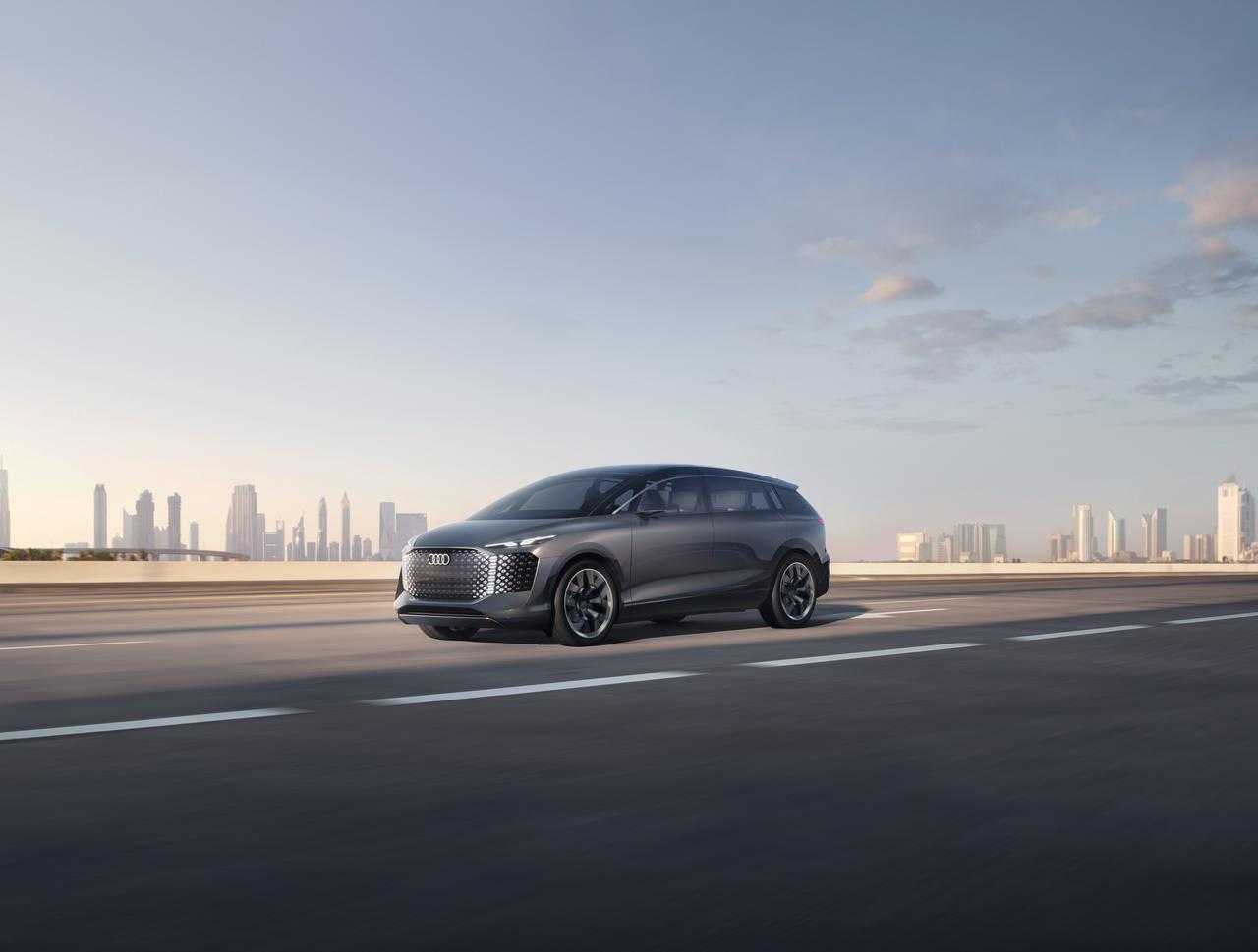
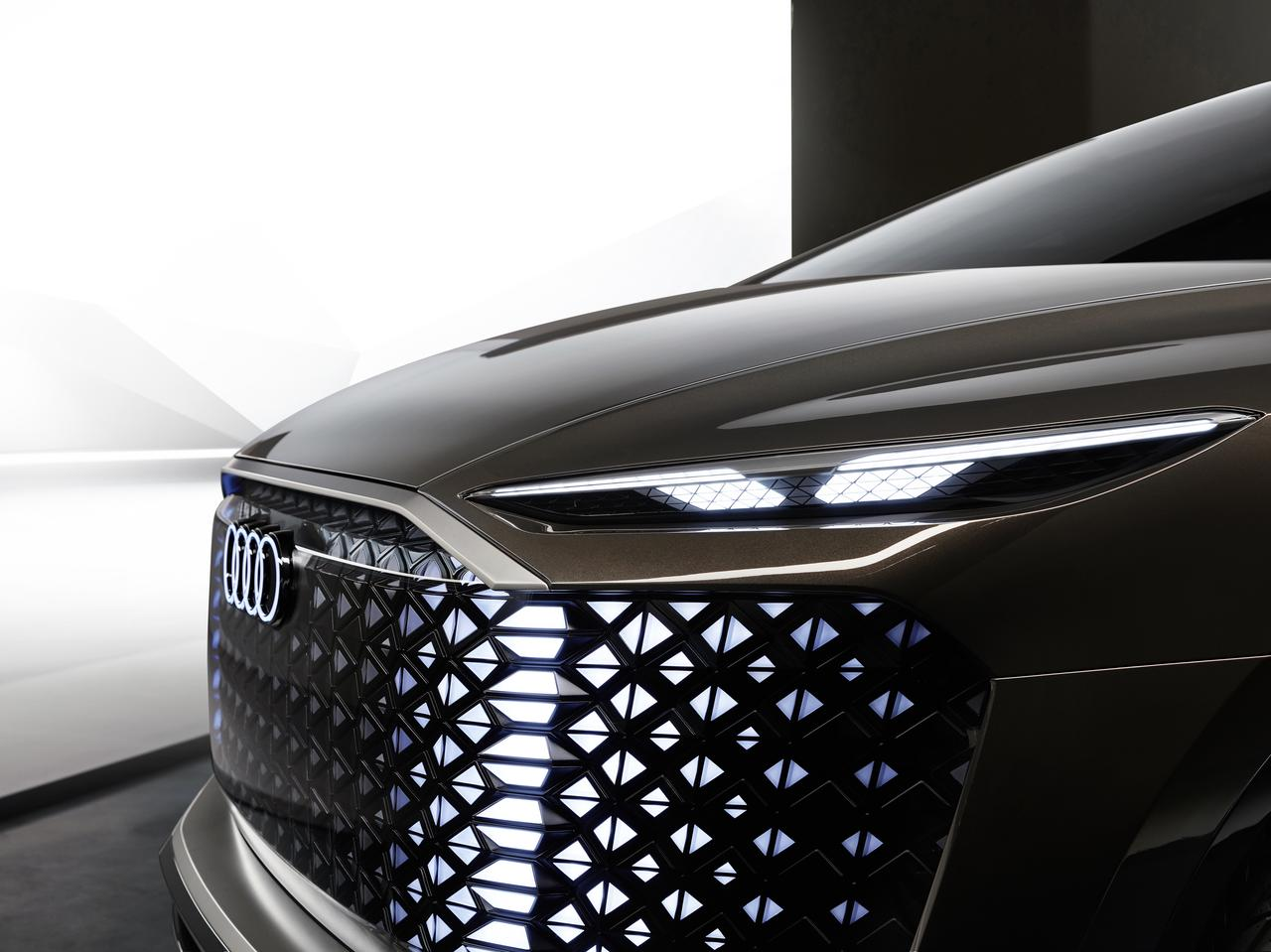
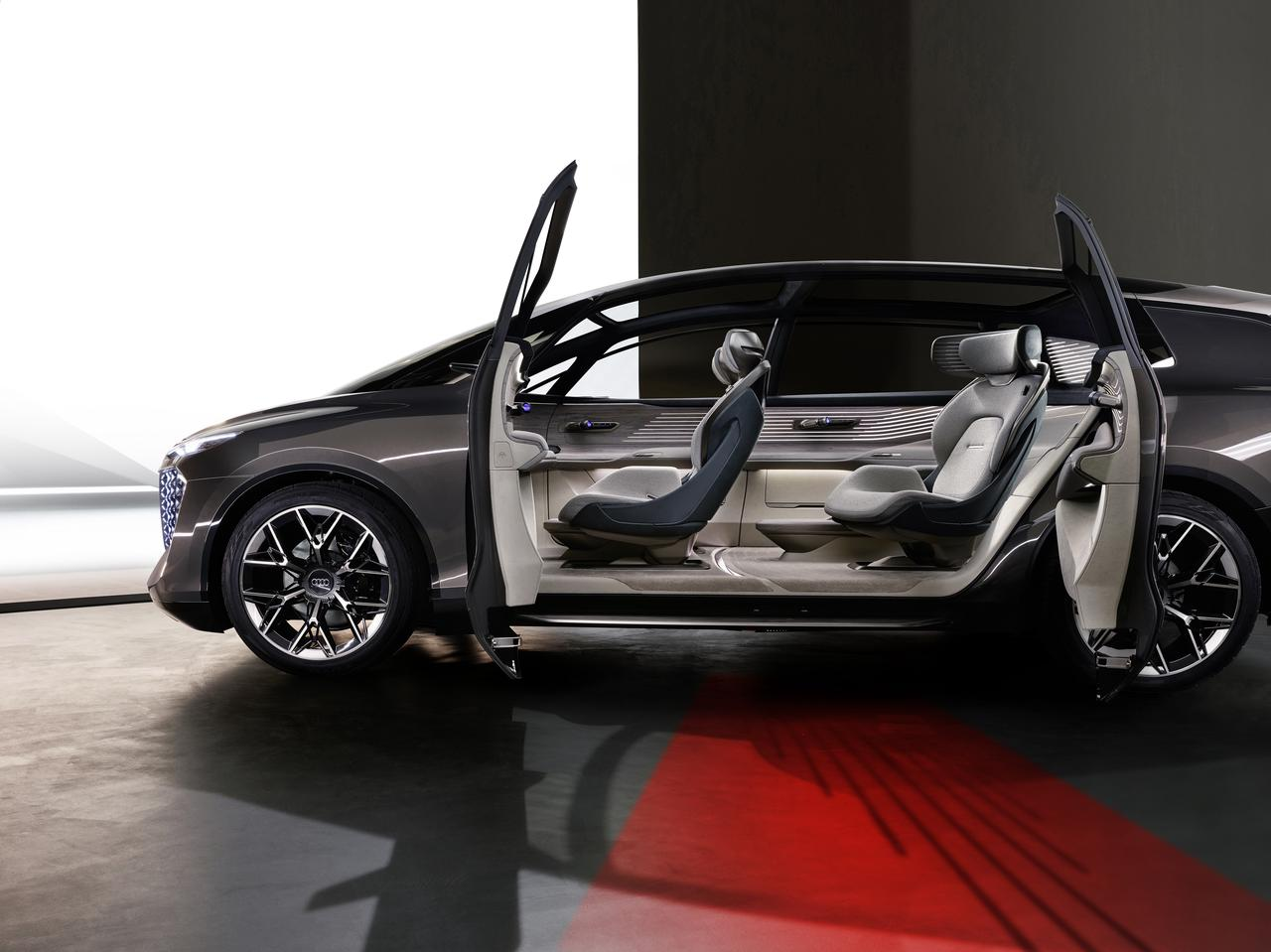
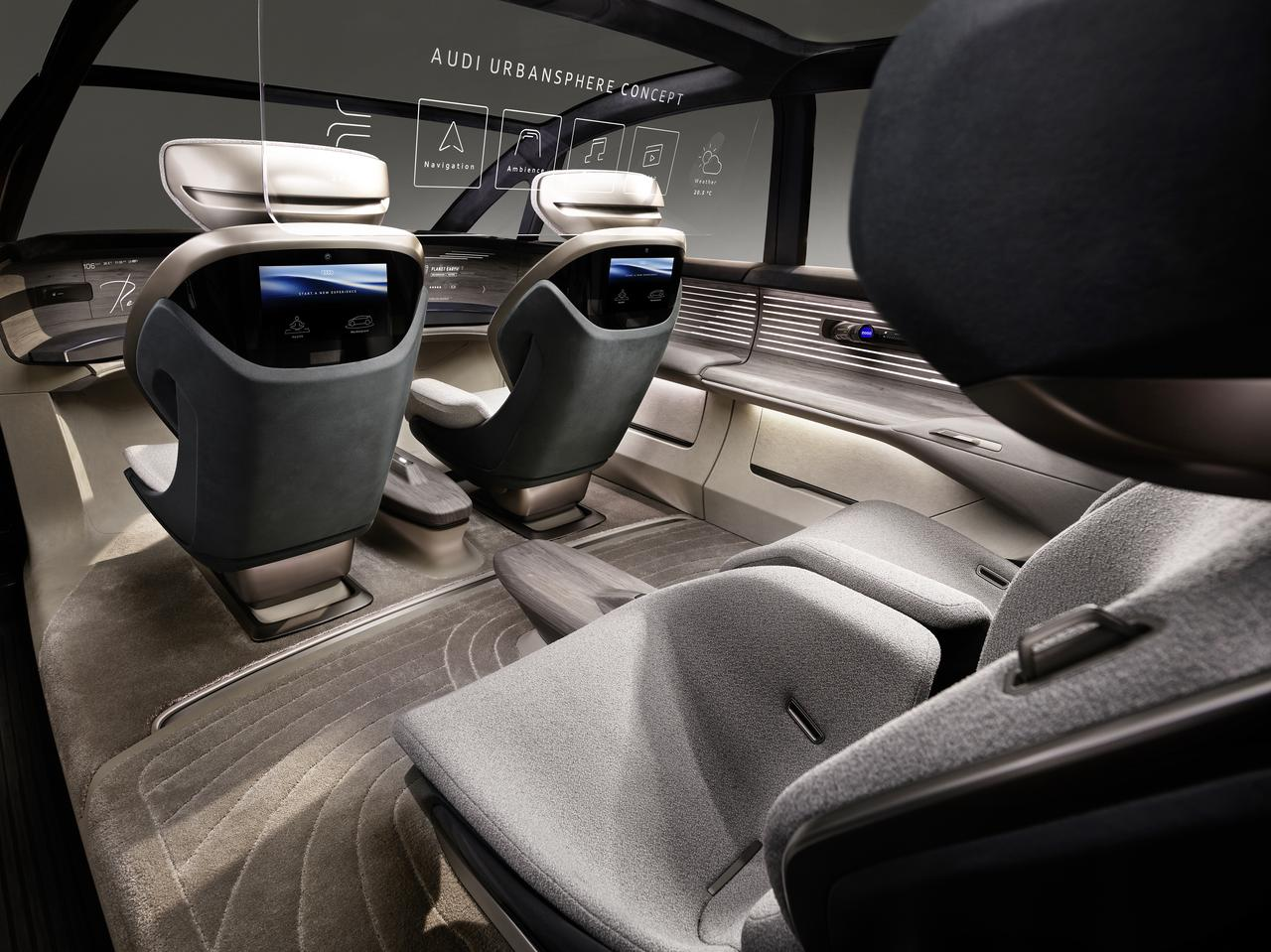
Quick Review:
EQS SUV, i7, and Urbansphere are aimed at customers who want to buy luxury electric SUVs, executive sedans, and MPVs. However, the Chinese MPV market in 2022 is already foreseeable to be overcrowded with new energy MPV products to be launched and sold by various car manufacturers including (but not limited to) Voyah, BYD, Zeekr, and Ziyoujia. Since electric motors and batteries have been introduced into vehicle design, it seems that from executive sedans to SUVs, and even to MPVs, they can be scaled up and down as needed. Immature and imperfect pure electric experience is no longer a reason to just consider electrification. Instead of keeping a low profile, purchasing tickets to board the train may be a better strategy to seize the ecological position.
The new vehicles of the three German luxury car companies (BBA) exactly correspond to the three categories of “designing luxury electric vehicles” (SUVs, sedans, and MPVs). Regardless of whether the product foundation is a hybrid or pure electric platform, or even a somewhat unrealistic concept car, what represents the reflection of traditional car manufacturers on the proposition of “luxury in the electric era” is the product ultimately delivered to consumers. The past glory is hard to shine on the future, and the difficulty of change lies in “realizable commitments.”
This article is a translation by ChatGPT of a Chinese report from 42HOW. If you have any questions about it, please email bd@42how.com.
